S.O.S. Help!
Friday, March 26, 2010

Doug Jasinski and his other smart co-workers at the design firm Skunkworks designed (a web page that even if I am unable to be completely objective I must say is just right!)my web page in the waning days of 2005. It was up in January and by January 20 my web page had an attached (ancillary) blog. You can see what that first, and rather inauspicious looking posting looked like above!
I had no idea what a blog was or its purpose. My first reaction to Doug Jasinski was to enquire why my blog had no provision for comments. Within minutes the feature was installed and within hours I quickly found out why Jasinski had not given me that feature in the first place. There were all sorts of nasty comments which I could not handle emotionally nor did I have the time to remove. In short order I decided that besides not allowing comments I would refrain from rants were possible and I would never carry ads or do quid-pro-quo linking to other blogs or websites unless it was my personal choice. I never installed any device to tell me how many people click on my blog. When I press on the “Publish” spot in Blogger I have no idea of where my blog is going to.
The original purpose of this blog (and one that I now know with certainty) is to satisfy myself. Not only does it do that but it has stifled (eased) the frustration that I have suffered in the last few years in being unable (as magazines and papers have gone into decline and no longer maintain or have the willingness of having a healthy relationship with freelancers). My blog has become my de facto and personal magazine in which I “publish” the pictures I want and write what I want.
That my blog has also satisfied members of my family was unintended by I am happy for them. They were curious about my past and were reluctant to ask me about it. The blog has answered many of their questions.
This blog has made me realize the depth of my photographic archives and there is no doubt in my mind that I will be rich and famous (when I am dead).
The folks at Skunkworks gave me what I wanted and I am not sure they knew what I wanted nor did they know what they were giving me. What they gave me (perfection!) was a custom URL domain blog that is driven by FTP. At the time (2005) FTP was cutting edge but not anymore. This means (I am not all that sure so my explanation will be hazy) that my pictures (in my computer's hard drive) and the copy I write all get transferred to a server. The server in question is by the company that hosts my web page. They are called Net Nation. From Net Nation the pictures and copy then are transferred to Blogger. In Blogger I have learned to use what I thought were limited formatting tools so that I am able to place pictures here and there and have copy wrap around them very much like a magazine. My friend Tim Bray, the Guru of Sun Microsystems and now a resident Guru at Google Android suggested back in January 2006 that my blog have an RSS feed and an individual URL address for every blog posting of the day. Skunkworks installed them and the rest is my blog history.
If any of you readers out there would ask me, “Are you happy as you blog is right now?” I would assert that I am indeed happy and that I would not want to change any of it. Unfortunately I recently received this letter (but I must point out that the deadline mentioned was extended to May 1):
Dear FTP user:
You are receiving this e-mail because one or more of your blogs at Blogger.com are set up to publish via FTP. We recently announced a planned shut-down of FTP support on Blogger Buzz (the official Blogger blog), and wanted to make sure you saw the announcement. We will be following up with more information via e-mail in the weeks ahead, and regularly updating a blog dedicated to this service shut-down here: http://blogger-ftp.blogspot.com/.
The full text of the announcement at Blogger Buzz follows.
Last May, we discussed a number of challenges facing[1] Blogger users who relied on FTP to publish their blogs. FTP remains a significant drain on our ability to improve Blogger: only .5% of active blogs are published via FTP — yet the percentage of our engineering resources devoted to supporting FTP vastly exceeds that. On top of this, critical infrastructure that our FTP support relies on at Google will soon become unavailable, which would require that we completely rewrite the code that handles our FTP processing.
Three years ago we launched Custom Domains[2] to give users the simplicity of Blogger, the scalability of Google hosting, and the flexibility of hosting your blog at your own URL. Last year's post discussed the advantages of custom domains over FTP[3] and addressed a number of reasons users have continued to use FTP publishing. (If you're interested in reading more about Custom Domains, our Help Center has a good overview[4] of how to use them on your blog.) In evaluating the investment needed to continue supporting FTP, we have decided that we could not justify diverting further engineering resources away from building new features for all users.
For that reason, we are announcing today that we will no longer support FTP publishing in Blogger after March 26, 2010. We realize that this will not necessarily be welcome news for some users, and we are committed to making the transition as seamless as possible. To that end:
o We are building a migration tool that will walk users through a migration from their current URL to a Blogger-managed URL (either a Custom Domain or a Blogspot URL) that will be available to all users the week of February 22. This tool will handle redirecting traffic from the old URL to the new URL, and will handle the vast majority of situations.
o We will be providing a dedicated blog[5] and help documentation
o Blogger team members will also be available to answer questions on the forum, comments on the blog, and in a few scheduled conference calls once the tool is released .
We have a number of big releases planned in 2010. While we recognize that this decision will frustrate some users, we look forward to showing you the many great things on the way. Thanks for using Blogger.
Regards,
Rick Klau
Blogger Product Manager
1600 Amphitheatre Parkway
Mountain View, CA 94043
[1] http://buzz.blogger.com/2009/05/ftp-vs-custom-domains.html
[2] http://buzz.blogger.com/2007/01/blogger-custom-domains.html
[3] http://buzz.blogger.com/2009/05/ftp-vs-custom-domains.html
[4] http://www.google.com/support/blogger/bin/answer.py?hl=en&answer=55373
[5] http://blogger-ftp.blogspot.com/
----
This e-mail is being sent to notify you of important changes to your Blogger account.
I have a May 1 deadline to migrate my blog to a Blogger supported custom domain but I have no idea what my blog will look like. Blogger asserts that my blog (FTP driven) represents less than 5% of the blogs they maintain. I have no idea if my blog address will change. I have no idea of what would happen should the migration abort. I suspect that the folks at Net Nation would have the blog all backed up. I don’t even know that. I have been unable to get an answer from the several computer gurus I know. The answers to my questions are not there because my questions are much too specialized even if the questioner knows absolutely nothing about it!
I make an appeal to any reader out there with a similar problem who just might have some answers. Blogger which is committed to supporting this blog until May 1 has been disrupting it for the last three weeks as I am unable to publish pictures or copy without repeated efforts that in some cases take hours.
And I almost don't have to point out that my return email to Mr. Rick Klau never received an answer. For anybody who might want to help I can be reached by the Contact Submission section of my web page.
This blog is now located at http://blog.alexwaterhousehayward.com/.
You will be automatically redirected in 30 seconds, or you may click here.
For feed subscribers, please update your feed subscriptions to
http://blog.alexwaterhousehayward.com/feeds/posts/default.
Fetish For Fishnets
Thursday, March 25, 2010
Well my sweet baby wears fishnet stockings
When she starts a rockin' there ain't no stoppin'
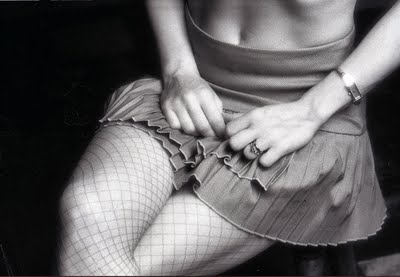
Singing wop bop a doo dop fishnet stockings
Shoo wop a doo dop when she's rockin'
Bop bop a doo dop there ain't no stoppin'
Rockin' with my baby in her fishnet stockings
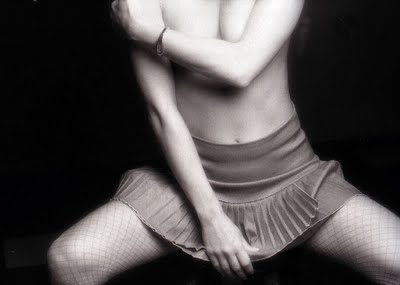
Well she's got a pair in pink
She's got a pair in red
When she puts the black ones she makes me loose my head
The Stray Cats

As far as I know I am not a sexual deviate. I dislike fetish and fetish photography. I don't understand the pleasure of tying up people or being tied up. My tastes are pretty simple. But I do like fishnets. In fact I would venture to admit that I have a fetish for fishnets and particulary if the fishnets happen to be torn. I connect fishnets with sleezy, dark and mysterious. Which is why I have a particular liking for the pictures you see here of Roksana, the Polish-born banker who lives in London. She dresses and looks like a sophisticated James Bond woman. She has money. She seems well-bahaved. It is because of it all that Roksana shines in fishnets. If I had had the time for more photographs I would have photographed her in a private school uniform. That's another fetish of mine, in case you didn't know.
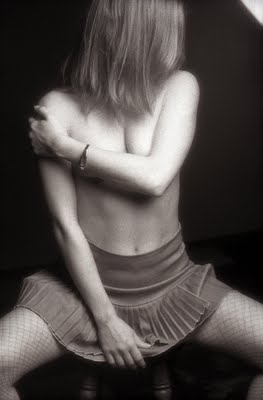
A few years ago I was driving North on Granville and I crossed King Edward Avenue. That is where York House School is. As I was passing the bus stop on the Northwest side of Granville my right eye caught two York House students in a passionate embrace. They were kissing. I almost lost control of the car I was so shocked and affected by the sight.

The particular look of the first 6 pictures here is the result of using the now sadly discontinued Kodak b+w Infrared Film. One had to shoot through a deep red filter (a No. 25) and once one focused one had to unfocus to the infrared mark on the lens. Infrared film's spectrum focuses at a different distance. Most photographers who ever used the film tended to print their pictures light. Mine here (or at least on my monitor) are darkish which is the way I like them. I have a few rolls of Kodak Infrared film in my freezer and I am looking for the appearance of someone like my Polish banker to pose, perhaps in fishnets.
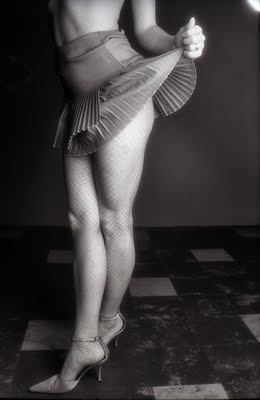
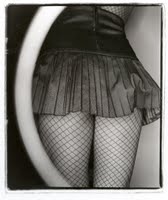
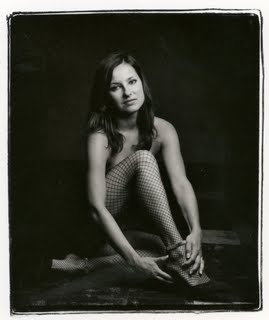
Joji's Is Still There
Wednesday, March 24, 2010
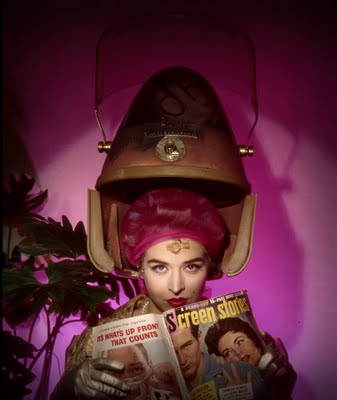
You can sit and look at art in a gallery. At Joji’s you can have your hair done too. Borrowing the idea from the yearly Artworks On The Drive, when stores on Commercial Drive display art on the street, Joji has a monthly art show in her salon. She has featured Jan Crawford, Dana Irving, Katarina Thorsen and the photographs of Natasha Moric.
Joji, from Hull Quebec, has been on the drive for five years and says, “I have brought a downtown salon to the Eastside. Many of our clients are artists who are demanding. We are up there with Suki’s as one of the ten best in town. We believe in doting over and papering our clients to the hilt. You can sip coffee from Casa del Café while you get your Japanese shampoo.” If it weren’t enough you can always walk down a block to Joe’s Café, buy that special Mexican Chicken at the Nazarene Market, up a block, or stock up with groceries and vegetables at the Santa Barbara Market next door.
If you don’t spot Joji in her gaucho hat at your next appointment, don’t be surprised. She is probably perfecting her style at the London Academy or the School of Vidal Sassoon.

If you wonder about the above piece an example of “service oriented editorial drivel” I can only cite my ignorance on the matter. I wrote it for Western Living sometime in the late 80s and I am not sure they ever ran it accompanied by my photograph of the beautiful Maurice and the Clichés groupie and model, D’Arcy.
Of the places mentioned Joji’s remains as does the Santa Barbara Market and Joe's Cafe.
In the heady days of magazines in Vancouver, the 80s!, we freelancers just didn’t wait for the phone to ring with the next assignment. We indulged in the daring sport called speculative work. In my case I photographed D’Arcy (film cost money) and interviewed Joji and then wrote the piece. The idea was that magazine editors were a tad lazy and they liked being offered a package. For me, this was not usually the case. It was easier for a writer to convince an editor on a speculative piece than for a photographer to do so with an editor. It was after a few of these failures that I began to concentrate on writing pieces without offering pictures to accompany them. My success rate improved and in most cases I was assigned to take the pictures
Damion Invites Me To Tea
Tuesday, March 23, 2010
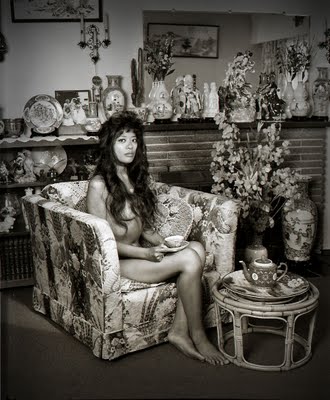
The first Chinese person I have memory of was a girl in my class at the American Grammar School in Buenos Aires. We were both in the fourth grade and she was the top math student and tops in just about anything else. Since she was the only Chinese person I had ever seen she was as exotic as any person could possibly be. She must have had an older sister or brother that my mother taught at the American High School as we were invited for dinner one weekend. The family must have been part of the diplomatic corps. I don’t remember much except that we sat at a table that had bowls and those wonderful “modern art” swoops that a Chinese spoon has always been for me. I was not an adventurous eater but I managed to stuff it all in without asking what it was.
When we arrived in Vancouver in 1975 I got my first real taste of cultural diversity. I marveled at the men in turbans and the bustle of China Town.
In the late 70s I began to frequent the Drake Hotel. I had become a fan of ecdysiasts. The profession had little ethnic variety. It did not go any further than, as an example, English Ana (as we called her) or “Emma Peel” which was her stage name. The one truly exotic exotic was Damion. She was a Canadian Chinese. Why she had chosen the profession I never did ask.
Romans and Greeks were noted for their noble noses and we can single out beautiful legs, large eyes and flowing hair in persons. But when it comes to singling out such bits as breasts, even when they are beautiful we must keep our mouth shut or be labeled sexist.
Damion had beautiful breasts and a flowing dance style. She used her long black hair for strategic cover during part of her performance.
I photographed Damion in her living room sometime in the 80s. Her house was on Marine Drive by the Knight Street Bridge. Somehow the noise of the trucks outside was ameliorated by the cozy situation of her living room. I took 20 pictures of her. I studied every one of them under a loupe today before I scanned one. To my dismay I had not taken one single one in which her nipple was not showing! But thanks to the “censorship tool” of Photoshop, Damion, once again, strategically covered that which must not be shown here.
The next day after our portrait session, Damion woke up with chest pains. She was rushed to the hospital and was, right then and there, subjected to open heart surgery to save her life. I never saw her again.
Camellias, Tea, Soot & Menstrual Cycles
Monday, March 22, 2010
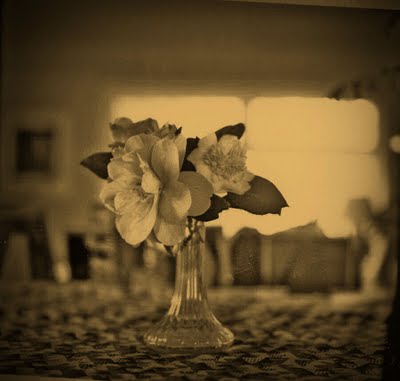
In our bedroom we have a large antique lawyer’s bookcase full of botanical books we began to purchase in 1986 when we moved to our current corner lot on Athlone Street. In it I have all my American Hosta Society Journals since I became a member in 1992. When Rosemary became interested in clematis or hardy geraniums or I suddenly could not read enough about roses, ferns, hydrangeas or euphorbias we bought the corresponding books on them.
Of all the books in the bookcase the only one I consult with regularity is Peter Beales’ Classic Roses. I also know that in the dead of winter I can discern hope in the spring by reading Christopher Lloyd’s pithy books on gardening. His books are opinionated but accurate almost as if they were written by a botanically enclined John McPhee.
For the last few weeks the four camellias in our garden have been showing off. I have been thinking how I could scan the flowers and write about them for the blog. The idea came yesterday when I received a phone call from my friend Mark Budgen who wanted to compare notes on our mutual like for very good loose tea.
Anybody who has gone beyond the usual “flow-thru” and un-ritualistic cup of contemporary brew that passes for tea must know that all tea (as in black and green) comes from one plant and that the plant in question is the lowly Camellia sinensis (its flowers do not compare to those of its flashier cousins) Camellia japonica and other species camellias and cultivars.
When the Brits showed interest in the liquid in the beginning of the 19th Century the crafty Chinese shipped plants of Camellia japonica. In spite of its beautiful flowers the leaves will not brew any tea of consequence.
The story of tea is told best by a woman called Frances Perry who wrote many books on plants. We have one of them called Flowers of the World – Illustrated by Leslie Greenwood – Foreword by The Lord Aberconway and published in collaboration with the Royal Horticultural Society, 1972. This with Peter Beales’ Classic Roses would be my desert island botanical tomes of choice.
Here is what Perry says (verbatim) of the camellia in its connection to tea (and along the way I find about the correct pronunciation of the word!).
The genus is named for Georg Kamel (Latinized as Camellus a Jesuit priest (1661-1706) who was particularly interested in natural science. He collected plants in both the Philippines and China although opinions differ as to whether he brought back Camellia seeds to Europe. Certainly he was responsible for introducing the St Ignatius Bean to Europe (Strychnos ignatii), one source of strychnine, and he also wrote a history of the plants of Luzon.
Economically the most important species is Camellia sinensis, the Tea Plant, the national beverage of China and one much prized by the English. Many tales and legends surround this plant, an especially charming story referring to an Indian Prince and Buddhist monk called Bodhidharma. This Prince is supposed to have landed on the shores of China in A.D. 510 with the object of converting its natives to Buddhism. To that end he dedicated his life to sleeplessness but one day, after years of wakeful teaching, praying and meditation Ta-Mo (as he was known to the Chinese) fell asleep. Mortified by this weakness of the flesh he cut off his eyelids and threw them on the ground where Buddha caused them to sprout and take root. These became the first Tea plants, the dried leaves of which assume the shape of eyelids and are supposed to represent and induce wakefulness.
Their employment as a beverage is supposed to have been discovered by another Buddhist. He lived the frugal life of a hermit and one day while making a fire with branches of Tea plant he accidentally dropped some leaves in a pot of boiling water. Later he tasted the liquid and finding it exhilarating and pleasant to the palate imparted the discovery to others. And so in course of time the practice of tea-making spread.
Around 1606 the Dutch set up Tea plantations in Java and soon afterwards brought this new beverage to Europe. In 1650 Peter Stuyvesant took it to North America although curiously it was 1652 before Tea reached England…Camellias (pronounced mell not meel)…

I cite the above information simply because of my paradoxical situation of wanting to keep all my books and at the same time realizing I don’t need them anymore. If I want to find information on why soot seems to appear on the leaves of my camellias (a common malady of camellias in our climate) I will find all the relevant information on the net. Few of my books unless I look into a specialized camellia book (I don’t have one) will explain that the black soot is a fungus or ‘sooty mould’ growing on the sugary honeydew secreted by aphids or scale insects. The honey dew drips down from the insects to the upper surface of the leaf below where the mould then grows. Although not harmful to the plant itself, the mould is a certain indication of the presence of one or other of these pests. It is readily moved with a cloth and warm soapy water, but to prevent its reappearance the root cause of the problem must be tackled. Although there are many types of scale insect, the one most commonly found on camellias is Pulvinaria floccifera, known as Cushion Scale or Cottony Camellia Scale.
They appear as small (up to about 5mm long), oval shells, ranging in colour from yellowy-green to brown, and found anchored limpet-like to the underside of leaves and sometimes on the stems. In late spring/early summer the females lay their eggs, which appear as a characteristic trail of white fluff behind them. The adults then die, and may drop from the leaf, leaving only the eggs behind. These hatch a few weeks later, and the tiny crawlers’ disperse themselves over the plant, or are blown by the wind to neighbouring plants, before attaching themselves to a leaf and beginning feeding. It is at this stage of their life-cycle that the insects are most vulnerable, before their waxy shell is fully developed.
Aphids are to be found on the soft, new growth and, later in the season, on the developing flower buds. Like scale insects, aphids are usually found on the underside of leaves where, undisturbed, they can rapidly form large colonies. As the plant growth hardens they will move on, but not before having distorted the foliage and formed lots of honeydew. Prevention is better than cure, and small numbers are easily controlled by wiping off with a damp cloth, or spraying with a jet of water. In fact I spray my camellias with a solution of warm water and dish soap and then I hose them off. A lot, but not all of the soot disappears.
In other botanical journals I found out that the British (and the East India Company) were stymied in not being able to get tea plants from the Chinese. In the 1840s English botanical adventurer Robert Fortune snuck into China and dressed as a Chinese potentate spied around and learned that both green tea (unfermented leaf) and black tea (fermented leaf) came from the same Camellia sinensis. He bribed officials and spirited plants out of China to India. Most died but enough survived and the rest (and why we have Assam and Ceylon tea) is history.
The camellias in my garden consist of two we purchased, one that came with the garden and one (the white one) that I liberated years ago from a nearby home that was going to be demolished. In the picture on the left is Camellia x willimasii ‘Donation”. On the far right there is a spent flower of Camellia x williamsii “Aunt Mavis’ (the earliest to bloom camellia in my garden) selected and named by my friend Alleyne Cook. In the middle at the top is the original camellia of the garden some sort of camellia japonica. I do not know what the white one is. But it is the white camellia that finally answered my question of why Alexandre Dumas’ (fils) novel The Lady of the Camellias is called so.
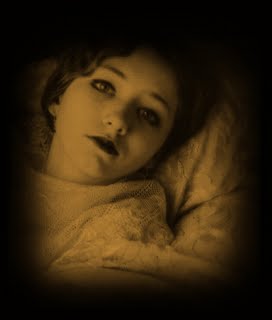
In The Lady of the Camellias by Alexandre Dumas Fills translated by Sir Emdond Gosse and with an introduction by Toril Moi, Moi writes:
In chapter II we learn that Marguerite was called the Lady of the Camellias because she was always carrying a bouquet of camellias. “For twenty-five days of the month the camellias were white, and for five days they were red; no one ever knew the reason for the change of colour, which I mention though I cannot explain it,” the narrator (p. 15) disingenuously declares. The visible and public sign of Marguerite’s menstrual cycle, the camellias signify her sex and signal her sexual availability.
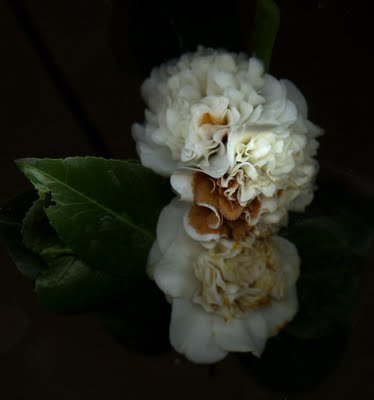
Camellias, moreover, are particularly fragile flowers; they quickly turn brown, and for a long time they were not terribly popular. One commentator claims that they were disliked because the flowers drop off intact “like the head of a man decapitated by a sword.” Thus the very name “the Lady of the Camellia reinforces the novel’s obsession with the connection between a woman’s sex and her death
Vancouver Urban Affairs - Air Rushing Into A Vacuum
Sunday, March 21, 2010
I am no longer accustomed to throwing in my two cents on civic issues, except around dinner tables and in canoes on distant lakes. But I am ready to join those who are concerned about the Vancouver Art Gallery's (VAG) decision to move to Larwill Park (aka, the old bus station site at Cambie and Dunsmuir).
Darlene Marzari, March 17, 2010
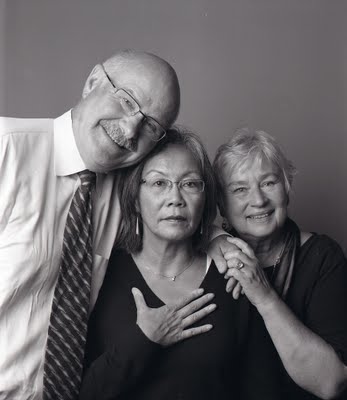
Darlene Marzari (seen here in picture, with from left to right, Mike Harcourt and Shirley Chan) has and intelligent take on the moving of the Vancouver Art Gallery in an op-ed essay Think City (a web magazine on Vancouver City urban affairs) here.
I sent the link to my friend Mark Budgen who replied with:
Interesting. Why is it that Think City, a coalition of so many esteemed organizations, has so little influence in what actually happens in Vancouver?
Budgen’s short statement left me bewildered and I spent most of Sunday thinking of an answer. Budgen and I talked on the phone and we echanged e-mails. In one he wrote:
I ask because they[Think City] seem to have some good ideas that are tweaks rather than fundamental thoughts as to the direction of the city for the next several decades. It wants a ward system but Sam Sullivan successfully saw that off a few years back. What about metropolitan government? Taking control of transit? More taxing powers for the city? A police force that crosses boundaries just as the crooks do?
I thought about it hard and suddenly I had a memory of walking on Beatty Street some years back and looking into the window of the restaurant that serves American Southern style barbecue. I spotted two men deep in conversation. One of them was Vancouver Sun columnist Vaugh Palmer and the other was then Editor-in-Chief John Cruickshank (below). Watching them I felt a sense of comfort. I knew that these two intelligent men were somehow discussing the state of our city and of our province. With them around I felt that things would happen for the better.
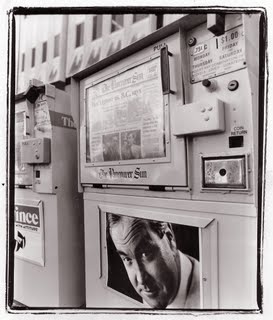
I don’t think that vision would ever repeat itself. That newspaper, like many others is in a rapid decline of importance in our city’s and province’s affairs. Cruickshank moved from Vancouver to the Chicago Sun Times, from there he went to the CBC and now he is the influential publisher of the Toronto Star. He is often heard in CBC panels on current affairs. I respect the man and I only wish he would return to our city. Of Vaughn Palmer I can only repeat what others have told me. And that is that as soon as he had his TV program his written views somehow became diluted.
There are other Vancouver Sun columnists I admire like Miro Cernetig, Ian Mulgrew and David Baines. John Mackie every once in a while writes excellent columns about the state of our city’s architecture. I would wish that garden columnist Steve Whysall would perhaps tackle city landscaping issues. Columnist Pete McMartin writes city oriented pieces every once in a while to make me think what the trio of Cernetig, Mulgrew and McMartin could do if they honed their direction into just civic affairs.
With the loss (thank God!) of our infamous stock exchange I find that David Baines’ watchdog columns on those dishonest traders would best be directed towards issues such as the one of city politicians dancing with developers. I am sure that Baines would discover stuff that would perhaps begin to help wane the outrageous influence that developers have in our city.
Many would say that the Vancouver Sun is a paper in decline and going towards a state of irrelevance. I would strongly disagree. Just the publishing of Abraham Rogatnick’s views against the moving of the Vancouver Art Gallery a couple of weeks ago on their editorial page generated many intelligent comments on subsequent days in the pages of the newspaper. I would suspect that the publishing of Rogatnick’s manifesto led Darlene Marzari to write her essay on the matter.
The Vancouver Sun still has influence but like papers in other cities and countries it has suffered the dilution of influence as people read stuff on the web.
Fifteen years ago Vancouver Magazine editor, Malcolm Parry would run a story, every couple of years, on the state of radio, TV and the city’s newspapers. These articles were articles that people read and talked about. These articles generated op-ed articles in the media. People were talking. Discussing which restaurant serves the best sushi will not create city buzz.
The same could be said about the Georgia Straight under the tutelage of Charles Campbell. The paper was more than film reviews and alternative scene rock concerts. Writers such as Ian Gill would reveal damning facts about the logging industry. Sean Rossiter wrote many informative articles on the state of our city's architecture. There were lots of investigative essays on urban and provincial affairs. At the time the paper hired and promoted freelance writers. That task is now an insurmountable one on the shoulders of its editor and other editors who must not only edit the paper but edit their own features.
My friend Mark Budgen says (as we discussed the thinning of influence of conventional media) that the only publication that covers the small affairs of our city that influence us in our daily lives is the Vancouver Courier. I am aware that this publication not only publishes a West Side edition but also another for the less monetarily advantaged section of our city. The paper tries to cover our city’s demographic. But increasingly I find that the paper is drifting towards bad-taste-irrelevance (Kudos & Kvetches) and busy-bee Allen Garr finds himself with too much honey in his pot. Budgen and I both agree that the Courier’s influence is waning.
Neither of us watch TV but we suspect that there is not one news person with the clout of yesteryear’s Jack Webster. Does Rafe Mair influence people to talk in our city streets? I doubt it.
Many would point out that our conventional media is being replaced by blogs and web-based social networks. Of this I have my doubts. Francis Bula has a very good blog here. She raises issues that are often ignored by her former paper, the Vancouver Sun. Yet…
I would venture to assert a suspicion that the people who read Francis Bula are the same people who read the Globe & Mail which certainly has been tackling the issue re the moving of the Vancouver Art Gallery with lots of gusto. These people are mostly secure in their jobs (they have jobs) and after reading the intelligent commentary they withdraw into their private lives.
There are blogs that spread stuff like wildfire in other cities. But Vancouver seems to be immune from a passion for city politics. Things happen here like air rushing into a vacuum. Nature hates a vacuum some say. It is about time we decided to fill our city with a city pride that is beyond the wearing of red jackets made in China for a store chain owned by Americans.
Or as Mark Budgen wrote:
There's no media paying attention to civic issues, no columnist, no leadership on issues outside politicians. At least, none that can make themselves heard.
The Sony Shuffle, Copland's Appalachian Spring & Queen's Bohemian Rhapsody
Saturday, March 20, 2010

March, 21, 2010
Dear Diary,
Yesterday I had a wonderful day, I spent most of it either cooking or going shopping for the ingredients of our traditional Saturday evening meal. Rebecca made an excellent fresh strawberry cobbler and Lauren played alone in the garden and later helped her grandmother picking up dead leaves and other stuff she was cutting back. They filled our green refuse bins. Lauren then changed to a pretty blue dress and loosened her hair in prepartion for our guest.
Our dinner guest was John Lekich. After dinner we watched Lillian Gish in the 1920 D.W. Grifith silent film, Way Down East. I could write here what a perfectly delightful time we had even though the film ran for two hours. Lauren, 8, could not read the explaining titles that appeared here and there so she soon became bored. For Rebecca it might have all been strange as in several sections of the film Rebecca does indeed resemble a young Lillian Gish.
But I cannot write more about it as the idea that a blog is an electronic diary is not quite right. The original word blog was a merging of web and log. In Spanish we have the word bitácora which originally meant the daily log contributions of the captain of a ship. Captain Fitzroy’s log aboard the HMS Beagle has been of interest to many who have wanted to read another side of Darwin’s story.
A diary until the advent of the blog was a day book (another name given to personal diaries) was simply a record of a single person’s reactions to the events of the day. These would be positive, negative or they might meander through the doubts of the course of ones immediate life. Some diaries weren’t exactly diaries by strict definition but almost daily letters between two people. One example is the almost daily letters between Galileo and one of his nun daughters, Suor Maria Celeste. Most of the letters from him to her have been lost. So what remains is one history’s most fascinating diary. This diary is deftly compiled, in Italian on one page and in English on the other by author Dava Sobel’s book Letters to Father.
A personal diary never had the problem of potential problems with libel or plagiarism. A personal diary was mostly a person’s reactions to that day’s events.
Blogs have modified what our perception of a diary is. When possible I have tried to keep my blog in the trajectory of the old-fashioned revelations of which some might seem to be much too personal. Some who read my blog are aware that I sleep with three pillows or that I have Venice Bakery scissor buns for breakfast. I have no standard method for readers to interject my blog with comments. I am afraid of cranks out there so I prefer my blog going out there and fizzling out into the ether of cyberspace.
When possible I have avoided rants or blogs that begin, “I read the other day…” or “I read this in the Vancouver Sun and I think the columnist is out to lunch. And this is why I think so.”
For many who study the internet it is plainly evident that the bulk of the blogs and web magazines on the net, not to mention the social networks, all feast (in the shark frenzy sort of way) on the conventional media that the web is supposed to supersede.
This is why I rarely quote such publications (the ones that I read with interest from paid hard copy that comes to my front door every day) But I must quote today from a most timely article by the NY Times’ book reviewer Michiko Kakutani who from one very long and fascinating piece in Sunday’s, March 21, NY Times. I read it the day before as the Sunday papers comes crashing to my front door step on the night before. In this essay Texts Without Context – The Internet Mashes Up Everything You Know About Culture, Kakutani reviews 8 books of which I have read The Cult of the Amateur by Andrew Keen. The others are:
1. Reality Hunger: A Manifesto by David Shields.
2. You Are Not A Gadget: A Manifesto by Jaron Lanier.
3. The Shallows: What The Internet Is Doing To Our Brains by Nicholas Carr
4. True Enough: Learning To Live In A Post Facts Society by Farhad Manjoo
5. The Age Of American Unreason by Susan Jacoby.
6. Infotopia: How Many Minds Produce Knowledge by Cass R. Sunstein.
7. Going To Extremes: How Like Minds Unite And Divide by Cass R. Sunstein.
I am always reluctant to quote from this conventional media (one that I respect) but today I will make an exception as in one final paragraph Kakutani writes:
He [Jaron Lanier] points out that much of the chatter online today is actually “driven by fan responses to expression that was originally created within the sphere of old media,” Which many digirati mock as old-fashioned and passé, and which is now being destroyed by the internet. “Comments about TV shows, major movies, commercial music releases and video games must be responsible for almost as much bit traffic as porn,” Mr. Lander writes. “There is certainly nothing wrong with that, but since the Web is killing the old media, we face a situation in which culture is effectively eating its own seed stock.”
My reaction to the media that surrounds me is one that would be no different from that of other bloggers so I try to keep it a minimum, and paradoxically it steers me into the direction of an old-style written diary which is more internal than external.
It was precisely at eleven, on Saturday that I was listening to CBC Radio 2. They were playing Aaron Copland’s Appalachian Spring Suite (The Atlanta Orchestra Symphony directed by Robert Spano. After the 23.2 minute performance (and I know because I checked the CBC playlist for the day) a young man with a curious French accent (a most pleasant voice) began to reminisce of his life. The program is a new one called This Is My Music and it features hosts who may be famous musicians or in this case it was Alexander Mickelthwate, the musical director of the Winnipeg Symphony. Somehow he talked about pancake breakfasts and it all connected to the next piece in his program (until that point delightful and endearing). It was the Bohemian Rhapsody from Queen’s album, Classic Queen (composer Freddie Mercury).
I can understand that in such a program the host could offer Dmitry Shostakovich’s orchestration for Tea for Two and then perhaps offer Thelonius Monk’s solo rendition of Tea for Two.
In the unprofessional opinion of this old coot blogger the only connection between Aaron Copland and Queen might be the as-yet-undocumented penchant of Copland to emulate British actors like Laurence Olivier to emerge from a closet dressed as a woman.
CBC Radio 1 and 2, (and I will not digress on my distaste for the podcaster man of Radio 3 who shares a name, by sound, with Vivien Leigh’s former husband) are out to prove that we all want to listen to Queen and Copland. Those of us who love Copland will be turned on (so the CBC thinks) by the virtuosity of Queen and vice a versa.
Wonderful afternoon shows on Radio 1 now have middle of the road (and to this Iggy Pop and Johnny Thunders fan) mediocre, mainstream guitar strummers with inconsequential voices filling radio space between radio traffic reports (“There has been an accident on the Ironworkers Memorial Bridge”) and some excellent reporting and interesting guests.
My car radio has buttons set for CBC Radio 1, 2 and the French CBC Radio Station. I can now punch one after the other and get that guitar strumming music. When this happens (and it happens much more now than ever before) I switch to the CD player where I will be sure not to listen to Queen.
You might wonder why I am illustrating today’s blog with a scan of one of the rarest of my home garden rhododenrons. It is Rhododendron stenopetalum 'Linearifolium' also called the spider azalea because of the shape of its leaf clumps. The leaves are not quite 2 inches long. When you see it in bloom (it has tiny pink flowers) you would never suspect that this little plant (little in my garden) is a rhododendron.
I am using this plant to illustrate how sometimes I like to listen to music in a linear way. I like the order of music in old LP’s but the advent of CDs made it easy to skip sonic klunkers., I believe I must blame Sony for installing in its early CD players that damned button called shuffle. Shuffle has helped destroy linearity and we now have mashups and an increasing distate for what takes a large chunk of our attention span. I would call it the Classics Illustrationification [my what a complex sounding word!] of our world.
It was Sony’s Shuffle that brought us Copland’s Appalachian Spring followed by Queen.
So, dear diary, to conclude, I want to point out that the fact that I worship to the altar of linearity that does not mean I have to stick to it and I can wander off as I so frequently do here.
A Wandering Jew Returns Book & Édith Piaf Sings In Ste. Vierge, Saskatchewan
Friday, March 19, 2010
Obsession is an overwhelming passion for the intangible.
Joey Tremblay
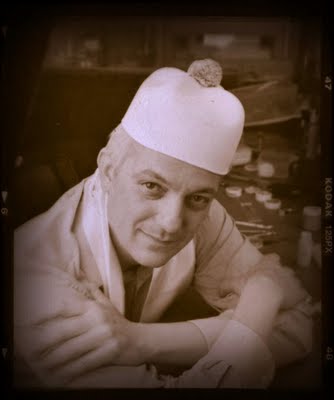
ELEPHANT WALK at the Cultch to March 20 (8.P.M. and Matinee at 2 P.M)
On Sunday Rosemary and I went to see the Chutzpah Festival play Underneath the Lintel (read about it in the second section below). We arrived home, thoroughly entertained but exhausted watching actor Christian Murray’s 80 minute one actor performance as a Dutch librarian obsessed in getting answers to the riddle of a book returned 113 years after it was borrowed.
Underneath the Lintel was really good but we were unaware that the play would be matched in entertainment and intensity by Elephant Wake at the Cultch which we saw, two days after, on Tuesday. This play, also a one-actor, one-act play features actor and playwright Joey Tremblay. Elephant Wake premiered in a shorter version in Edmonton 14 years ago is a Globe Theatre (Regina) production directed by Bretta Gerecke (and sets, and lighting and costumes!). It is 90 minutes long and the minutes go awfully fast. While actor/playwright rejects any who might think that this play is autobiographical, he did live in a small French Canadian community in Saskatchewan (Ste. Marthe) that somehow ceased to exist when a nearby, much larger Anglophone town competed for business.
A way of life ended and Joey Tremblay poignantly (funny, too, when you hear his terrific impersonation of Édith Piaf) tells the story of the decline and eventual disappearance of a way of life through a 75 year-old man who is not too smart, has a big heart and is the last living inhabitant of the fictional Ste. Vierge. Gerecke’s set design is an integral part of this performance. There are two reasons why you might not want to take children to his play. One is the occasional swearing and insults to Her Britannic Majesty and the other is that your children will soon deplete you of all your newspapers and flour.
When Rosemary and got home we were as exhausted emotionally as we had been with Underneath the Lintel. I have become convinced that both plays are about obsession. Underneath the Lintel (read below) is about an obsession to find the truth. The second, Elephant Wake, is I believe the obsession of one man who may have had this play in his head and an ever warm back burner for many years.
I went to photograph Joey Tremblay (above) yesterday and I was not in the least surprised to find out that he was having a nap in his dressing room. I don't see how a nap could possibly help him outlast the grueling performance wating for him that night. When he opened the door I was amazed that the 75 year-old man Jean Claude of the play, may be in his late 30s. He posed for me with one of the props (a French priest’s hat). As I left I asked him how he would define obsession in one sentence.
Without too much reflection, Joey Tremblay said, “An overwhelming passion for the intangible.” I am sure that the Dutch librarian and Christian Murray would both agree.
One of the positive side benefits of the restoration and improvement of the Vancouver East Cultural Centre is that its director, Heather Redfern had to move plays and other productions to other venues which resulted in co-sponsored productions like the on with Chutzpah a the Norman Rosthein Theatre and I could not forget to mention the three-way involvement with the Arts Club Theatre, and the Push Festival of the Catalyst Theatre production of Nevermore: The Imaginary Life and Mysterious Death of Edgar Allan Poe last February. Redfern has also traveled and has been bringing us the best of these travels. It was in 1995 that she first saw Elephant Wake. We can be grateful to her that she did.
While there have not been any big white Chinese elephant sightings in Saskatchewan I would advise any motorists approaching Welby, Saskatchewan to keep their eyes peeled on the road.
UNDERNEATH THE LINTEL (7 P.M. to March 20 at the Norman Rothstein Theatre) part of the Chutzpah Festival
When my granddaughter Rebecca accompanied me, some years back, to a concert of the Pacific Baroque Orchestra held at St James Anglican on East Cordova I told her that the church was as Roman Catholic as it could possibly be but still be Anglican. Her curiosity led her to ask me to explain to her the 14 Stations of the Cross on the wall. When I got to Station 5 I told her that my Spanish, and very Roman Catholic grandmother had told me that El Cirineo (Simon of Cyrene) had been a reluctant Jew who was forced to help Jesus with the carrying of His cross to Golgotha.
It came as a surprise to find out there was a different and intriguing side to that story last Sunday when Rosemary and went to the Chutzpah Festival play, Underneath The Lintel (Presented with the Vancouver 2010 Cultural Olympiad and The Cultch and which is a Frankie Productions, Nova Scotia, performance).
This 80 minute wonder is a one man (Christian Murray), one-act play written by American writer Glen Berger. It is directed by Mary Vingoe with sets designed by Stephen Osler and lighting design by Ingrid Risk.
The play is about a small Dutch town librarian who is off on a search for answers when at his desk he finds a 113 year overdue travel guide book that has been anonymously returned. His obsessive curiosity takes him to London, Paris, Dingtao, China and Australia. Throughout the performance, in spite of the fact that I was being highly entertained I was both amazed and worried for the well-being of the actor. Such a performance must drain him. Not being an actor I will never understand what propels one to act in one act plays and suffer the agonies that must accompany such an undertaking.
This Nova Scotia production proves to me that not only is the one actor, one act plays alive and well in BC but also across Canada. In the past I have been amazed by one actor, one act plays featuring locals Lois Anderson, Bill Dow and Jonathan Young.
In Glen Berger’s version of the El Cirineo story a man is under the lintel of his home when Christ passes by carrying his heavy cross. Christ stops and gestures for help. El Cirineo refuses. Christ tells him, “You will wander, and not rest until I return.”
This is one version of the wandering Jew, a man who never sleeps, rests, sits down or settles to live in any one place for long.
The librarian begins to suspect that the man is somehow alive (but not well and wanting to reveal his existence with obscure hints) into the 20th Century.
Christian Murray deftly shifts between being the nerdish librarian who lusts after a better position, to the obsessed man, who in the end gives no importance to the possible loss of his job and pension. There are botanical and canine connections in the play that I will not reveal here.
If there is a problem, it would be which play, of these two, to see first. Underneath the Lintel runs until Saturday (7 P.M.) and so does the Cultch’s Elephant Wake (8 P.M.). But there is the extra opportunity of catching the latter as a matinee on Saturday at 2 P.M.
Yapa, Cholesterol & Blood Sugar
Thursday, March 18, 2010

From the late 60s to the early 70s in Mexico City, Rosemary and I went through a small generation of VW beetles. All were purchased new. By then the folks of Wolfsburg had pioneered an early version of computer diagnostic.
I would take our VW for service to the dealer and an obviously German manager would meet me in a pristine doctor’s white coat with a bulletin board in hand. His German accent, when he spoke Spanish, was plain enough to give me the comfort and trust that my car was going to be in good hands. Picking up the car the next day I would be given a computer print-out of the compression of each of the four cylinders. After a year or two I would see the unevenness between the individual compression figures to know that my brand new VW was aging. I would eventually get bills for brake drum repair or told that the clutch was slipping. It was almost impossible not to get a fender bash in Mexico City in a year. People often parked by ear and bumpers would be bent out of shape. It was soon evident that the up and up graphs of the compression measurements would start that inevitable decline. The shine of the new car would wane and that inevitable corrosion of the body and the decline of its mechanical parts would push me into melancholy.
At the time in the apex of my youth it never occurred to me that our little VW was mimicking the course of my own body graphed as the compression of four cylinders in a period of time.
Yapa is a Peruvian word that is used in South America to denote something extra. The 13th loaf of a baker’s doze would be called yapa (that y is pronounced like the Hungarian Z in ZaZa Gabor!). A peanut butter jar offering 15% more would be in Spanish 15% yapa.
yapa.
(Del quechua yapa, ayuda, aumento).
1. f. Ingen. Azogue que en las minas argentíferas de América se añade al mineral para facilitar el término de su trabajo en el buitrón.
2. f. Am. Mer. añadidura.
de ~.
1. loc. adv. Am. Mer. además.
2. loc. adv. Am. Mer. gratuitamente.
Real Academia Española © Todos los derechos reservados
I believe that half a century of existence is just about right and that anything over that is yapa.
For most of my life I have eschewed exercise and a too healthy diet. Rosemary and I eat well. We have lots of fresh fruit and vegetables.
It was a few months ago that my daughter Hilary convinced me to see one of those half & half doctors. These are doctors that are 50% conventional and the other 50% is dedicated to prescription of natural medicines that will equalize or improve blood sugar counts etc.
I went to see the woman and she insisted I have one of those thorough blood tests. One of them involved a full fast which meant that even though I was not looking at the woman removing the blood (“Are you a vampire? I asked her.) or the blood being removed I felt faint. I had to repeat the procedure that afternoon.
Then I had to wait for two weeks before the tests were sent to the doctor and then another week before an appointment was made for me to see it.
Would the tests reveal cancer of the pinkies or failure of my adrenal glands to secrete adrenalin which would mean that I would never ever have the pleasure of losing my temper or feeling stress?
I went to see the woman with that fear that I had when I would take my VW to face that white-robed paragon of Teutonic efficiency.
It seems that my blood sugar is up a tad as is my cholesterol (the nasty one not the nice one). The doctor recommended chromium (will my new found health make me shine like my VW’s brand new bumpers?) and niacin. I am to go back to the vampire for a blood test in a month to see the results. Meanwhile I have been told to exercise. Perhaps I will walk with Rosemary. Perhaps I will reduce the sugar in my tea from two to one teaspoon. Perhaps I will eat fewer carbohydrates.
But I am not going to try too hard. After all, with a half a century gone in my life the rest is yapa.
Flaming Facebook
Tuesday, March 16, 2010

By the end of 1994 my friend Celia Duthie was talking about the World Wide Web and something called wimsey. I had no idea of what she was talking about. She compounded my confusion by telling me about a new powerful Sun Micro System device that was going to make her bookstore an on-line store.
In March of the next year with the help of Duthie I opened an account with a local service provider called wimsey and I was given my first e-mail address alexwh@wimsey.com. I remember calling the wimsey tech support chap one day and he asked me, “It’s raining here on 4th Avenue. What is it doing by your neck of the woods?” Little did I know that pick-up-the-phone-and-call-for-tech-support would be a thing of the past and soon I would be talking to persons in Rumania who would not help me with my FTP blogging problems. We would be having no-language-in-common problems.
Then I went to Duthie’s with my wife’s IBM laptop (it was called a think pad at the time) and I connected to the internet for the first time. Duthie went to France and I decided to pitch a story to Equity Magazine about a daily e-mail communication with Duthie in France. The article was published in May 1995 as (Almost) on-line from France with Celia Duthie: diary of a techno-illiterate's battle to send an electronic letter. The techno-illiterate was, of course, me!
At the time I was barely able to use my computer. My friend Paul Leisz had written me step by step instructions which began, “Turn computer on.”
For close to 6 years I wrote articles for magazines and newspapers by using a Smith Corona Word Processor. I would print out my manuscript and then type into Eudora which was an early equivalent of Microsoft’s Outlook Express. One of the editors I submitted my stuff was Nick Rebalksi at the Vancouver Sun. He never objected to my format method. It was later around 2003 that I finally stopped using the Smith Corona and learned to use Word.
Shortly after getting connected to the internet I joined an Electronic Round Robin of the American Hosta Society. It was a de facto social network many years before the likes of My Space and Facebook. And it was a bit more that the contemporary electronic bulletin boards of the time. Before I joined that electronic round robin I had been a member of the plain round robin. I was part of a group of 6 hosta enthusiasts who would write in a letter and enclose it in a package that included the letters of the five others. Some of us were lazy and sometimes it would take a couple of months for the round robin to makes its rounds. One of the members of the robin was Alex Summers, the founding member of the American Hosta Society. He had wonderful and intelligent things to say but his handwriting was illegible! We were civil and I enjoyed the process.
The electronic round robin was much more direct and there were many more than 6 members in it. It was, looking at it with contemporary hindsight a specialized botanical community out of something like Facebook.
We all had opinions ( Is hosta hyacinthina a species Hosta hyacinthina or a cultivar Hosta ‘Hyacinthina’) and we rarely were uncouth. Those who were uncouth were flamed. It was fun and soon I was at it more hours than I should have been. There was one member of the robin (a friend of mine who lived in the US Midwest who decided to play a prank. He stayed up at night and was known to drink heavily. He had mastered the technique of having many email identities. With a couple of them he would write opinions contrary to his own opinions and then fan the flames between his two personalities. Soon our robin was a mess and people were insulting each other. I caught on (it seems that in spite of my low techno-illiteracy I had been able to read the clues). I called him up and he told me he was having a ball.
Soon one of our members, who was a lawyer, had hired another to write up a “constitution” that would regulate behavior in the robin. We were summarily given two days to sign or opt out. Many of us, including me, cited the constitution as being neo-Hitlerian in character and we signed off. My friend, the culprit, signed and remained. I never returned to the robin.
I past years I have been members of photographic forums (these are similar to the American Hosta Society Round Robin) and in no time photographers are insulting each other and moderators intervene and banish the offenders for days or permanently. I quickly lost interest in these forums. A typical photographic forum question might be, “Do you ever get sexually excited when you photograph a nude woman?” or “Which is a better camera a Canon EOS Jaguar Four-Door or a Nikon Lumix V-8?” The perennial, “Which is better digital or film?” garners tons of back and forth insults. If you happen to point out that a posted picture has flaws you are quickly told that your opinion was not asked.
A friend living in Spain wrote to me telling me she wanted me to look at her pictures but that she did not know how to send me jpegs. I was to join Facebook so I could see them. I reluctantly did this under my official first name (in Spanish) and with my mother’s maiden name. I saw her pictures and then became curious about Facebook. After a year of it I have gotten multiple requests from men in Barcelona and in Madrid who want to be my friends. Mexican photographer Pedro Meyer sent me a request for me to be his fan!
Perhaps what I dislike the most about Facebook is the unreal concept that those in a circle or community live in a world where everything is “gosh, that’s lovely!” and people exchange platitudes in increasingly Twitter-like brevity.
I don’t have a Facebook circle since I mostly read what some of those would-be friends write about while I “publish” photos in my wall with comments on them (all in Spanish). A few days ago I saw some photographs of a Spanish model/photographer with whom I e-mail some years ago. She lives in Madrid. These pictures were taken by another photographer. They made the freckled-faced beauty look older, rough and downright unattractive. I wrote a comment (I should have known better) that I longed for her to take more self portraits and that the photographer in question should perhaps switch to another profession. I was immediately lambasted with several comments that I should keep my comments in a positive way and that the photographer in question was really a good guy and was an excellent photographer. I stuck to my guns and wrote another comment (I should have known better!) that there are photographic standards and that at the present rate photography as we know it is drifting into a uniform mediocrity. To make it all worse I quoted my grandmother in Spanish. One quote refers to our Darwinian origins, “He showed his tail.” And the other “Ignorance is daring” is all about the fact that now anybody can “publish” any photograph, anywhere, any time.
This got me into hot water and the photographers around the model’s social circle went after me with a vindictiveness that was scary. I did nothing and called my own retreat.
In a world where we still have tests and grades in schools it is evident to most that there are good students and bad students. We cannot all excel in the same profession. Yet in Facebook all photographs are wonderful, exciting, interesting and nobody calls a spade a spade.
I cannot reconcile the idea that some can and some can’t with the politically correct concept that we all can if we try.
I am giving Facebook a skip. I should have known from my days of the Electronic American Hosta Society Round Robin.
Lillian Gish - First Lady Of The Silent Screen
Monday, March 15, 2010
First Lady of the Silent Screen
By John Lekich
Special to the Globe and Mail
Friday, October 24, 1986

At 90, Lillian Gish can’t seem to shake the habit of talking with her eyes. Some 75 years after making her silent film debut in D.W. Griffith’s An Unseen Enemy, her eyes can still swell with a purity of emotion beyond speech. As the light from the window of the Meridian Hotel coffee shop sifts across her delicate Victorian features, it’s almost possible to believe that the slightest sound would be a pointless intrusion.
Gish recently attended the closing gala of the Vancouver International Film Festival, where Jeanne Moreau’s Portrait of Lillian Gish was screened. The woman dubbed “The First Lady of the Silent Screen” not only speaks plainly, but with impeccable diction that befits a former pupil of Toronto’s legendary Mrs. Carrington (the vocal coach who, as John Barrymore once confided to Lillian’s sister Dorothy, “saved me from being nothing more than a fifth-rate actor”).
Among the animated tones, there’s enough honest wisdom to explain the late Griffith’s contention that Lillian Gish “is not only the best actress in her profession, but has the best mind of any woman I have ever met.”
Says Gish: “Oh, I have an awful memory. I could never lie because I would always forget what I said. So I had to tell the truth. And it worked out rather well. Because people tend to respect you if they know you’re just being yourself.”
Despite downplaying her memory, Gish, who once labeled Hollywood “an emotional Detroit,” vividly recalls a vast array of anecdotes that span several eras of show-business history.
A performer since the age of 5, she remembers dancing in a play opposite Sarah Bernhardt (“She was the woman who made it possible for children to work on the stage”), taking her first curtain call on the shoulders of Walter Huston (“I was so scared that I tried to run downstairs and hide behind some boxes”) and portraying Alan Alda’s “slightly off-centre” mother in his recent Sweet Liberty ( “I turned down the part five times because I thought he looked much too young to be any son of mine. But after a few minutes of looking into that beautiful face, I thought: ‘I’d work for this man for nothing’”).
“I never chose money,” she says. “I always chose people. I wanted to be around people who knew more than I did. I think that’s why I never fell in love with an actor. They never seemed to know any more than I did. I wanted to be with writers…My idea of a dream man was Thornton Wilder.”
Describing herself as “endlessly curious,” she’s resisted matrimony (“I’ve always love men. But I would never ruing their lives by marrying one”), traveled extensively (“I’ve been everywhere except China because I know I’d end up walking too much for my own good”) and sampled life on the other side of the camera (“In 1920I directed Dorothy in a film called Remodeling Her Husband. That’s when I discovered that directors don’t sleep well at night”).
Yet, curiosity had little to do with the Gish sisters’ initial involvement in silent pictures. Born a year apart, the girls had more pragmatic reasons for working in movies.
“We were hungry many times,” Gish says of a childhood that included a wandering father who refused to support the family and a struggling mother who “was as near to God as I would ever get.”
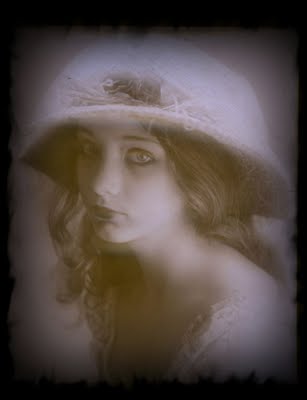
“The only place that would have us was the movies,” she adds. “And in those days, that was really scraping the bottom of the barrel. Our biggest fear was that someone from our home town in Ohio would see our name in the paper. In the Midwest, a proper girl got her name in the paper three times. When she was born, when she got married and when she died. Otherwise you were a loose woman.”
In 1912, neither Lillian nor Dorothy realized that, by simply entering the offices of Manhattan’s American Biograph Company after seeing neighborhood friend Mary Pickford in the movies, they’d end up changing the face of the silent screen.
In a time of crude photography, “where you were a character actor by the time you were 8,” Griffith put the two teenaged sisters to work immediately. Tying different colored ribbons in their hair so he could tell them apart (“He would shout: ‘Blue over here! Red over there!’) they began a relationship that would see Dorothy grow into a skilled comedienne, while Lillian became the era’s foremost dramatic actress through such Griffith classics as Broken Blossoms, Orphans of the Storm and his 12-reel epic, Birth of a Nation.
Gish has high praise for Griffith, the man credited with virtually inventing the language of filmmaking. Recalling his pioneering use of the close-up, she says: “The people in the front office got very upset. They came down and said: “The public doesn’t pay for the head or the arms or the shoulders of the actor. They want the whole body. Let’s give them their money’s worth.’
“Griffith stood very close to them and said: ‘Can you see my feet?’ When they said no, he replied: ‘That’s what I’m doing. I am using what the eyes can see.’ ”
Gish also helps to explain why his improvisational methods proved impractical with the advent of sound.
“The only writing you saw on a Griffith picture was his signature on your cheque each week, “she says. “There was never any script. You never knew what the plot was in advance. He would stand at the back of the room and call out the story as you walked through it a couple of times. Finally, freely and without thinking, you said whatever lines you felt the character might say in that situation. That was the direction. That was the way I worked for nine years.”
The same creative faith often overlapped into instances where she would risk life and limb. Nowhere is this more evident that in the 1920’s Way Down East. In one of the screen’s most unforgettable moments, the climax finds Gish lying on a huge ice floe, her long, flowing hair and the fingers of on hand trailing across the frigid water as she heads for the falls.
Holding up her right hand she exhibits a couple of bent fingers. “It was my idea to put my hand and hair in the water, she says. “The water was so cold that it burned. I had no idea it was going to hurt so much. Of course, you can’t blame anybody but me for that.”
She has steadfastly refused to use a double throughout her career. “I’ve always felt you could tell the difference,” Gish says. “People move differently…Of course, in those days, everybody fell off everything. I can’t tell you how many times I’ve been thrown off a horse.”
Working well before the development of unions also meant putting in 12 hours a day with not time for anything else but sleep. While she once worked 25 hours at a stretch before her bloodshot eyes prompted a disgruntled cinematographer to send her home for a restorative nap, the actress looks upon those early days with Griffith as among the best in her life.
“We were like a family,” she recalls, painting a picture far different from the Fatty Arbuckle and William Desmond Taylor sex scandals that would later rock the infant industry. “With Griffith there were definite rules. We weren’t allowed to kiss anybody. If a scene called for it, you’d put your lips near the leading man and the camera made it look like they were touching. But we never actually did it.”
She remembers when the theatrically trained John Emerson was lent to the studio to direct the 16-year-old Dorothy in 1914’s Old Heidelberg. “They came to a scene where John said, ‘All right Dorothy, now you kiss so and so.’ Dorothy just looked at him and said: ‘Oh we don’t do that sort of thing in this studio!’ ’’
The issue of to kiss or not to kiss split the company in half, but “pretty soon,” Gish says, “The actor’s wife called our mother and explained that it was quite all right for Dorothy to kiss her husband. He had no diseases and it wouldn’t hurt her. So Dorothy had to do it. But, since neither of us had ever been kissed, she didn’t exactly relish the idea.”
In 1913, Gish migrated to Hollywood in search of weather that would allow Griffith’s company to use sunlight all year long.
“There was no Hollywood then,” she says. Griffith invented it. We worked out of a little shack on the outskirts of L.A. where the city used to store their streetcars. But I thought we’d found paradise. It was orange blossom time and the mockingbirds would sing you to sleep every night. It was so beautiful.”
But she would never forget Griffith warning her about the very thing he had helped to create. “He said, ‘Don’t let this place fool you. It’s very good for your body and very bad for your mind and soul.’ Of course, he was right, but somehow I managed to survive.”
Not that surviving Hollywood was easy. By mutual consent, she reluctantly left Griffith for a higher salary and greater creative control – eventually joining MGM in 1925. Stepping off the train from New York, she began a lifelong friendship with Irving Thalberg, the studio’s wonder boy, by mistaking him for the baggage clerk.
“He looked all of 18 years old,” Gish says of the man F. Scot Fitzgerald would later use as the model for The Last Tycoon. “He was a wonderful, brilliant man – consistently amused by the fact that people were always taking him for the office boy.”
Her relationship with Louis B. Mayer was far less pleasant. She credits Mayer- the only person she expresses even the vaguest dislike for – with putting a virtual halt to her film career throughout the thirties.
“He always insisted that any film with an unhappy ending would ruin your career,” says Gish, whose handpicked projects with MGM included King Vidor’s La Bohème and Victor Sjostrom’s Scarlet Letter. “L had seven unhappy endings.”
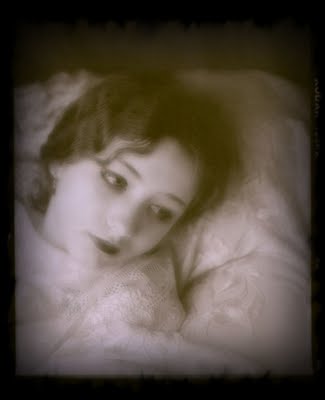
While such films proved successful, they worried the commercially conscious Mayer. “He called me into his office one day and said” ‘You’re sitting way up there in a pedestal and nobody cares. Let me knock you off and everybody will care.’
“He wanted to stimulate box office by creating a scandal for me the way he did for John Gilbert and Greta Garbo,” Gish says. “He said that they had Garbo now and they really didn’t need me. So if I refused to play along, he’d make sure I never got another job in the movies.
“I thought to myself: ‘I’m going to have to give a performance on screen and off screen if I am going to be a sex symbol. I went back and told him: ‘I’m sorry Mr. Mayer. But I don’t have that much energy.’ ”
Finding jobs scarce in Hollywood she returned to the stage, where Jed Harris offered her the role of Sonya in the U.S. premiere of Chekov’s Uncle Vanya (“Harris was like Griffith,” Gish says. “A genius. I got along well with genius.”) Subsequent roles included Ophelia opposite John Gilgud in a legendary performance of Hamlet (“Gilgud didn’t play Hamlet, “Gish says. “He was Hamlet”), and an 18-month run in Life With Father (“I spent a year and a half running upstairs. That’s a lot of exercise when you include matinees).
“I found that I truly loved the theatre,” she says, adding that her only regret was that a play prevented her from attending Griffith’s funeral in 1948. “But the best part of being on the stage was that I didn’t have to go back to that mean Mr. Mayer after he tried to ruin my career.”
Through it all her stipulation for accepting work has been the thought of trying something different with people she admires. (She accepted her role in Robert Altman’s A Wedding because “he said you die, but you die with comedy, I like that.”)
Gish characteristically refused to say anything negative about the current state of the movies. “I don’t see enough films to make a judgment,” she says, “although I laughed until I cried at Tootsie. And Ghandi was four hours that seemed to go by in four minutes.”
Still, she admits to missing silent films, and tours with her favorite, 1928’s Wind, every chance she gets. “At that time,” Gish says, “only about 5 per cent of the world could speak English. Silent pictures not only changed the world, they controlled it. Then with a smile that makes you wonder why they ever bothered to make talkies in the first place she adds: “Who knows? Maybe some day they’ll come back.”
Re-published by kind permission of the author.
The portraits here are not of Lillian Gish but of my granddaughter Rebecca Stewart who rose to the occasion when I suggested the project to her.
Alex Waterhouse-Hayward
A Regal Lauren Surprises The Old Man
Sunday, March 14, 2010
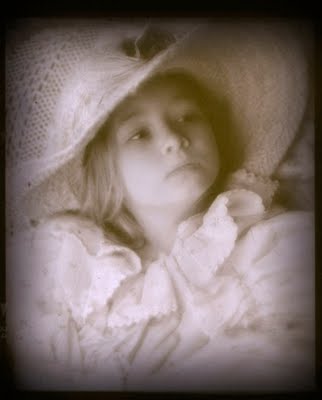
I have known Rebecca for all of her 12 years and Lauren for 8. It is difficult not to feel some sort of favouritism as Rosemary and I have traveled with Rebeccca to Argentina, Uruguay, three times to Mexico and once to Texas and Washington DC.
It was two weeks ago when I asked Rebecca to come into the garden to help me weed the rose bed that she told me, “I first have to go inside to put on some makeup.” I found this most strange so I told her, “You don’t need makeup to help me weed.” But she went inside and came back out with dramatic eye makeup. I was almost shocked not because I knew that her parents did not allow her to apply that much makeup except to play, but because I saw a resemblance. “Rebecca come inside and let me show you something.” I went to my computer and Googled Lillian Gish. The resemblance that Rebecca has to a very young Lillian Gish is quite remarkable especially with the heavy eyeliner under the eyes and very dark lipstick.
Of my attempts to photograph Rebecca as Lillian Gish yesterday I will write on another day.
While I was taking pictures of Rebecca in the dining room Lauren was under the dining room table. She was distracting Rebecca and I told her to go. But Lauren said, “I want to see.” As soon as Rebecca went for a rest Lauren took her place and posed for me. I almost dismissed her but then I realized that I had to take her picture, one way or another if only to keep her happy.
I finished with Rebecca leaning against a sofa. She protested that her neck hurt. I was beginning to tire of her prima donna performance so I finished taking her pictures with half a roll of a very valuable roll of Plus-X Pan 220 film left. Lauren calmly stepped in with a straw hat and took Rebecca’s place.
I need not explain that she charmed me and looked regal. Today Paul Leisz visited and taught me some tricks on pseudo vignetting using Corel Paint Shop Pro X. I am most satisfied with my picture and I now look at Lauren as an exciting source of photographic inspiration.
Raising The Bar by Lenny Kaye
Saturday, March 13, 2010
Recently I ran a picture of Lenny Kaye in this blog which accompanied an In One Ear column by Les Wisman from Vancouver Magazine. It is here. Kaye saw it. He was most pleased. I asked him if he would write a guest blog on his take on the whammy bar. Today he delivered.
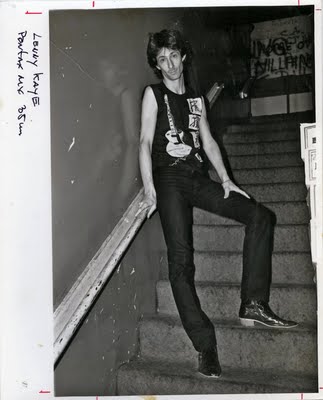
Raising The Bar
By Lenny Kaye
I call it a sway bar, but it is also referred to as a whammy, a whang, and – most descriptively – a vibrato bar. It’s the lever you see protruding from a guitar’s bridge, and when grasped and pulled up or down, has the ability to shift the pitch of a note, a chord, or even all six strings in one swift motion. It can be used tastefully, as in a slight wobble, or radically, replicating the vertigo of a dive-bomber.
Usually, except when the guitar has a Floyd Rose string-lock upon it, it exacts its price on the player: the dreaded out-of-tuning. But usually the effect, emphasizing a trailing arpeggio with a bit of squiggle, or tickling a note as it sails into oblivion, is worth it. Or at least I think so, or should I say sowowowowo….
I love the sway bar, seldom play an electric instrument without one fitted, and have often been tempted to bounce upon it as one might a trampoline. The undisputed master of the technique – apart from such godlike creatures as Jimi Hendrix and Jeff Beck, both of whom used it to play entire melodies – is John Cippolina of the Quicksilver Messenger Service. In such recordings as “Babe You’re Gonna Leave Me,” “Codine,” “Pride Of Man” and the epic journey that is “Who Do You Love Me,” he wrenched and moaned his solos so that they seemed spoken in a foreign lingual, shivering and wobbling each phrase that he poured out of his custom Gibson SG.
It was Paul Bigsby who first put a springlike vibrato tailpiece on a guitar in the early fifties, followed by Leo Fender with his synchronized tremolo arm on the Stratocaster (though of course, this is misnamed, since tremolo is volume alteration, something a mere grab of a handle cannot do).
Wherever and whencever it comes, it adds a degree of expression to the guitar that falls easily to hand. My hand, especially.
# # #
Shelina The Graceful
Friday, March 12, 2010

Shelina was a wondrous dancer at the Number 5 Orange Street establishment of Powell and Main in the last 70s. The D.J. at the joint had insisted she take ballet and dancing lessons as the D.J. himself was a prominent Vancouver jazz dance choreographer at the time. Shelina danced with grace. She danced like a slippery cat. Her body was lithe, and with no fat. Her curves were just right. She had a soothing voice and the only defect that made her pleasantly human was an ever so slightly prominent nose. I took some pictures of her at Wreck Beach sometime around 1979. I was experimenting with a red sensitive film called Special Order 410. It made skin look like porcelain. These pictures were my early crude examples of nude photography. Shelina was a patient subject, a delight to photograph.
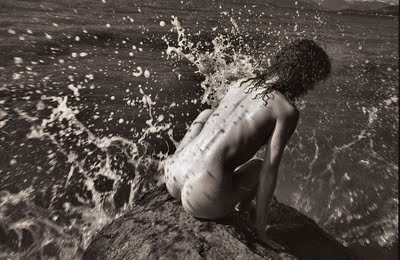
Some years later there was a reunion of the circa late 70s and early 80s dancers at the Number 5 and I was invited. While enjoying the company of these wonderful women and reminiscing of old times when “dancers” danced I looked at Shelina and thought hard. She must have read my mind because she said, “I will dance for you right now if you like.” She climbed up on the stage and this she did. And for the first time and most probably the last time I felt like a real king as she danced just for me with her trademark grace.
Thursday, March 11, 2010
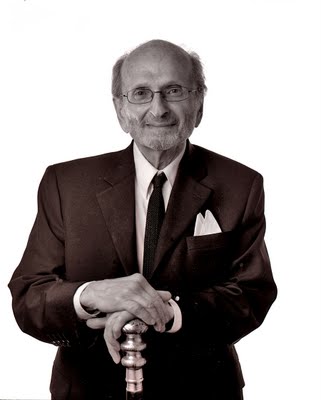
From the moment that I can remember being an individual I can remember my mother opening a heavy but small jewel box and showing me the heart of diamonds. Of all the jewels (purchased in Paris) that my grandfather Tirso de Irureta Goyena had showered on his bride and wife my grandmother Dolores Reyes de Irureta Goyena the only one that was left was the little quartz heart studded with diamonds. The rest of the jewels had been pawned off or sold to finance the divorces of my uncles and aunt.
When Alexandra Elizabeth (our first daughter was born in 1968) my mother told me that it was her will that the heart would be used to finance Alexandra’s university education. “I want her to have all the opportunities she deserves,” she told me.
Both Ale and Hilary managed to graduate from university here in Vancouver. Ale went to UBC and Hilary to Simon Fraser. What is to happen to that little heart of diamonds? I would think that my mother’s will, would transfer to our eldest granddaughter. We shall see and keep the little heart in its box.
Fulfilling the wills and desires of someone who is dead is something that most of us take most seriously.
I never thought that I would have to do this for someone else.
It was this past July that my friend Abraham Rogatnick shocked me with a statement that I first took lightly. He said, “If there is anything I want to do before I die is to go public on my stance that the Vancouver Art Gallery should stay put.” He wrote up his reasons and went to visit Vision Councellor Heather Deal. Deal red the “manifesto” and said something like, “Let’s wait and see.” Rogatnick told me, “I lost it and I yelled at her, what do you mean you are going to wait and see?”
I told Rogatnick to give me his manifesto and that I would try to see if anybody was interested. By mid August Rogatnick was ailing and I told him I had been unsuccessful in my efforts to get the radio, TV, web based magazines and our local newspapers interested. Rogatnick simply told me, “You tried.”
This past Monday I can say now that thanks to the intersession of the Vancouver Sun’s city columnist, Miro Cernetig, Rogatnick’s manifesto is up in today’s Vancouver Sun editorial page.
Rogatnick did not believe he was going anywhere when he died at the end of August of last year. I felt I had let the man down.
But Rogatnick was always pragmatic and he would probably agree with me that his manifesto might be that much more effective coming from the grave than when he was alive. My thanks to Miro Cernetig for keeping Rogatnick’s vision alive.
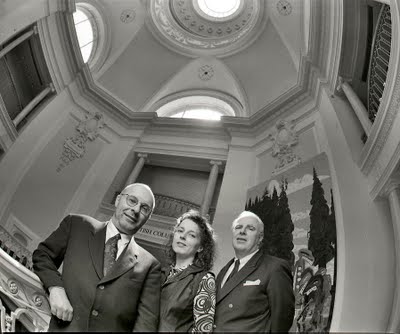
While driving Monday morning to Rona to purchase shady garden grass seed for my garden, I turned on CBC Radio 1’s Almanac and listened to Kirk Williams. He is the provisional host while Mark Forsythe is on holidays. Williams introduced a man whose voice was a dead ringer for Archibald Alexander Leach. It was a smooth and urbane voice. I would vote for the auditory doppelgänger or buy a used Toyota from him.
The Cary Grant impersonator was Michael Audain OC OBC Chairman Polygon Homes Ltd., Chair of the Vancouver Art Gallery Foundation, the Audain Foundation for the Visual Arts, and the National Gallery of Canada and most important is Chair of the group involved in the project to move the VAG to Larwill Park across from the Queen Elizabeth Theatre. He was calm and fielded questions (most listeners who chipped into the program were against the move) very well. He even managed to answer (it sounded good, I am not sure he made sense) when a speaker enquired about the in-the-red situation of the current art gallery and the fact that they are reducing staff and shortening their hours to save money.
It is understood that since the Province of British Columbia (which owns the property) does not charge the VAG rent, the reason for the red ink has to be explored and reconciled with a sum that would be upwards of 250 million Canadian dollars to build a new facility in the proposed site of Larwill Park which is the city block to one side of the Queen Elizabeth Theatre.
Larwill Park was a temporary (I understand that from the records) site of the Greyhound Bus Station. Previous to that it had served as a military parade ground and troops that were going to be sent to the Boer war were mustered there.
In the last few weeks several troubling incidents re: our city, have been revealed by the Vancouver Sun, the Globe & Mail and Francis Bula in her blog.
1. Under the mayorship of Philip Owen a deal was struck where the Vancouver Park Board sold Larwill Park to the City's Property Endowment Fund so that the Board could buy land along the Fraser River.
2. Subsequently we have found out that an office tower might be built in Larwill Park as a quid pro quo arrangement whereupon as Francis Bula writes in her blog(fragment of it in paragraph below)
The latest complication I discovered on Friday was that the city has already committed to using $48 million of the development profits from the site (most if not all of them) to pay for the QE Theatre renovation that happened in the past couple of years. More details on this confusing tale [in the Globe & Mail] here.
3. An article in the Tuesday Vancouver Sun written by Jonathan Ross explains why so much stuff happens in our city behind closed doors. It seems that many important decisions are made by our city bureaucrats and not by our elected officials.
4. Max Wyman told me he was privy some years ago to a meeting at the VAG that proposed the idea of incorporating the parts of the Simpson Sears building (designed by renowned international architect Cesar Pelli) with the VAG. An unnamed friend of mine said, “Douglas Coupland could place one of his airplane sized projects into that building with room to spare.” Wyman even told me that there were discussions involving he building of some sort of mechanical escalator between the VAG and Sears.
We (I) suspect that when Eaton’s had to vacate the site Cadillac Fairview (it leases the building from the city who owns the land) must have given Sears a sweet deal. But the sweet deal is not going to bring shoppers into a store that does not have a department that sells one of the Sears mainstays, Craftsman tools. I have to go all the way to Lougheed Highway to have my Craftsman lawnmower serviced. It would seem to me that if Sears could sublease part of the cavernous building, Sears, the VAG and we the citizens of this city would profit.
5. Miro Cernetig wrote an intelligent column on Monday on what is happening to our Robson Square Centre and particular in the light on how popular the location was during the 2010 Olympics.
To 5 I would add that I had several discussions on Robson Square with Arthur Erickson and my friend Abraham Rogatnick (who died in August 2009). It was our opinion that one of the biggest mistakes of our city was to bring in UBC to Robson Square.
The average person on the street is aware that Simon Fraser University is in town. Coincidentally he or she might even inform you that part of that downtown site on West Hastings was formerly a Sears store! I have attended countless seminars and lectures on urban affairs at SFU Downtown Campus.
How many people know that there is an important bookstore not far from Chapters on Robson and Howe? Few might know that UBC has a downtown campus in Robson Square and that the prestigious UBC Bookstore has a branch right there!
This general ignorance is that in my opinion UBC has botched its presence downtown. They have ill used the site and given it such a low profile that few know it exists.
In the past the Robson Media Centre (as it used to be called) had interesting cultural events in the premises and in particular in the Judge White Auditorium. It was in this auditorium whose sides had softly carpeted steps where some of us would slouch to listen to the likes of Arthur Erickson talk about our city. The auditorium was always full and I felt the richness of living with a city. I felt almost like an Athenian citizen of old.
What has happened to that auditorium? Is it used at all? This auditorium could be the very auditorium that Michael Audain says the VAG lacks.
It is my opinion (one I shared with Abraham Rogatnick) that UBC should vacate Robson Square and that it be taken over by the VAG.
In the photo above which I took for the Globe & Mail in 1997 that's, from left to right the then director of the gallery, Alf Boguski, curator Dana Augaitis and Michael Audain.
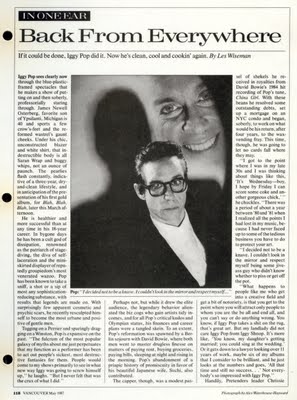
Quite a few years ago I was sharing my studio with another photographer. One day I walked into the studio to get a piece of lighting equipment and I found the photographer there. He asked me, “In a few minutes I have to photograph a woman called Carole Taylor (she was then a city Councillor) for the cover of Vancouver Magazine. Who is she?”
My friend and previous fellow collaborator Les Wiseman (he was the writer) for many a story for Vancouver Magazine and TV Guide told me that one of the secrets of good magazine writing is to research your subject. It would seem to me that this intelligent piece of advice also applies to photographers who shoot for magazines.
This advice has served me well. Researching my subjects has always enabled me to connect with the person facing my camera. Since many of these persons when shooting for magazines are some sort of celebrity or politician they usually don’t give you much time. You are forced to find a common ground of interest quickly if you hope to get a picture that will be different from all others. When I faced actress Helena Bonham Carter I knew her grandmother was Spanish. I had found this out through research. I had a suspicion Bonham Carter spoke Spanish. Taking her photograph, while in the presence of an intrusive writer who had brought his baby to the interview, I was able to bond with her when I spoke to her in Spanish. In fact Bonham Carter wrote me a letter in perfect grammatical Spanish thanking me for the fun she had.
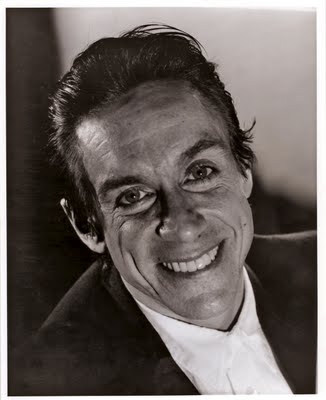
With the slow demise of many magazines many of the procedures that once were in effect have faded. At one time writers and photographers worked in tandem. Wiseman and I went to many rock concerts together and interviewed musicians back stage or in their hotels. Wiseman sometimes advised me as to what his tack was going to be in the interview. I would tell him what my possible approach to the photograph would be. But what worked best was Wiseman’s insistence that I remain in the room during the interview. It was here that I got many of my ideas for that photographic approach. This policy of allowing me to remain during the interview was also a technique shared with writers John Lekich and Christopher Dafoe. Both of them worked for the Globe & Mail. The former wrote as freelance art reporter and the latter was the arts correspondent in Vancouver.
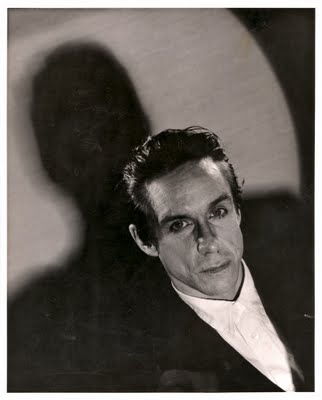
I have shot many magazine, tabloid and newspaper covers since 1975. I noticed something peculiar about some of my better covers. This is that sometimes they can only be used once, and only once. After that someone might ask,"So why that composite picture of Iggy Pop smiling?"
About 20 years ago I used to frequent the monthly meetings of an organization called CAPIC (Canadian Association of Photographers and Illustrators In Communication). The talk then was about selling stock. One of our members a persnickety South African born Paul Little (he worked as a stringer for Macleans) would tell us from the back row, “If you do stock nobody will ever pay you to travel to Paris to take pictures.” He was usually hushed. But time has proven him correct and few photographers are now paid to go to exotic locations to take pictures.
As I look at my extensive collection of photographs, slides and negatives (b+w and colour) I realize that I have never ever been able to sell stock. The reason is that my pictures are too specific to a particular article. They are not stock pictures of people in general. They are pictures of particular people who cannot play the role of everyman or everywoman for an ad. This means that my pictures have value in other directions but not immediately as stock.
As an example look at the composite picture of Iggy Pop here where he is smiling in the right hand corner. When it became time to pick a picture for the article/interview that Les Wiseman made in May 1987 I was promoting the use of the picture showing Iggy Pop’s hands. I had mentioned to Iggy Pop (it was Wiseman who had said in the presence of the man’s handler, “What are we supposed to call him, Mr. Pop? “) that his demeanor and look resembled the famous photograph taken of Joseph Goebbels by Alfred Eisenstaedt in 1933. Iggy Pop got all excited and told me, “I was in Geneva, not too long ago in the very spot where that picture was taken.” He then struck the pose for me. But Wiseman insisted that Iggy Pop had been transformed and that he was now clean of drugs and alcohol and that the most salient feature of the new man was his smile. And that is how I came to print the composite to please Wiseman.

An editorial collaboration involves give and take. That is part of the tension but also part of the fun. This blog is a de facto magazine of mine since I singly decide which picture or pictures to use and I edit myself. The freedom is pleasant but the collaboration is not there. The thrill (or disappointment, sometimes!) of waiting to see how my picture is used or cropped has always been special. It is my hope that magazines in some shape or form come back so that photographers and illustrators of the generation that follow me will experience the thrills and excitement that I have in collaboration with Les Wiseman and other writers.

Rebecca knows the meaning of the expression, “Who shaves the barber?” Every once in a while she will insist on taking my picture even when I am hovering around with my heavy medium format Mamiya RB-67 and my equally heavy tripod. These snaps were taken in June 2009 at the Nitobe Japanese Garden of the University of British Columbia. The girls and Rosemary love the place so we go often.

Rebecca was keen on photography a few years ago so we went to Leo's to buy her a digital camera. When it stopped working I bought her a new one. But there seems to be no follow up at home so she has lost interest even though she is so good in front of my garden. It is methodical Lauren who always wants to look through the viewfinder of my Mamiya and I am wondering if she just might inherit my vocation. It would be most pleasant to will all my useless film cameras (presently so useful to me) to my Lauren.


I don’t particularly like VanDusen manure Saturdays. It happens once a year and it happened yesterday. I drove over to pick up 12 bags of well rotted manure (it hardly smells) and brought it home. It was a nice enough day that I went at distributing it among my roses immediately using my large orange/red wheelbarrow. I mix the manure with last year’s fall VanDusen compost (another day I don’t particularly like). To this mixture I add handfuls of Epsom salt (magnesium sulphate) and generous amounts of alfalfa meal. The magnesium salts in early spring help the rose bushes absorb the nutrients that may be present in the soil. The alfalfa meal (which I buy at the Otter Co-Op in Langley) is supposed to induce roses to send up basal shoots (Nice thick and vigorous ones that grow to be healthy canes. These come up from the base root of the plant).
When Rebecca showed up at noon I told her that today Sunday we would to the same with her roses and that we would also prune them. And we would also transfer root-bound roses to bigger pots. I was going to bring a back of compost and a bag of manure plus my Epsom salt/alfalfa meal mixture.
I showed up at two and it was drizzling. Rebecca was dressed to the teeth and had a nice scarf draped around her neck and shoulders. “Do we really have to do this today?” she asked as she looked in the direction of a friend. It was obvious that I had interrupted a pleasant and lazy Sunday afternoon in which anybody with an attorney would be recommended to do nothing. I stuck to my guns, “We knew about it since yesterday. Let’s do it.” She accompanied me outside with her beautiful silver flats. I pointed out that she would have to change as she would be on her knees potting and mixing manure with compost. She relented and when she returned she was all enthusiasm.
We worked at her roses which all look very healthy in their pots even though most roses do not like to be in pots. Rebecca’s back yard is a concrete driveway so the pots are her only choice if she is going to have a garden. Her friend said, “You have a lovely garden.” Rebecca agreed even though her friend added, “Balfour owns this property and they don’t want to spend any money in landscaping; besides the home owners here want the space for their cars.”
While Rebecca’s garden is not big it makes up for it with an unusual collection of old roses and rare hostas. In May/June her backyard is a feast for the eyes and delight to the nose.
Her sister Lauren began her gardening a couple of years ago with my gift of some blue/yellow winter pansies. They are indestructible and they keep blooming every year. She also has a miniature hosta called ‘Peanut’.
Rebecca’s father predicted that Rebecca’s roses would all die this year, “She doesn’t take care of them.” I sort of beg to differ but I told Rebecca that this would be her challenge for the year by proving him wrong.
One of my loveliest rose in my garden is a Gallica of unknown origin called Charles de Mills. It blooms only once as Gallicas are old roses and this is their pattern. The blooms are complex with a myriad of petals. The flower itself seems as if someone went at the front of it with a sharp razor. The scent is heavenly and the flowers are a blue/crimson that defies description.
There is another attribute of this plant that is not generally known. It is one of the few roses that send underground runners (some go under wood fences) that grow to be little clones of the parent. After two years I severe the relationship with a sharp knife and re-pot the plant. This year Rebecca and my friend Paul Leisz are getting one. Paul’s is from last year while Rebecca’s is from two years ago. Last year her Charles de Mills (still in my garden) had at least 40 flowers!
I have placed many a picture of Rebecca with a rose in this blog. This particular one, taken last May/June, shows Rebecca, 11, more as a teenager looking to her adulthood. Her hair is adorned by a splendid example of Rosa ‘Charles de Mills’.
While Rebecca and I happily worked on her roses, her friend (in the drizzle) was busy texting with her thumbs. When I pointed this out to Rebecca’s father he said, “She is in high school. They all do that.”
Will Rebecca be like the rest? Will her love for roses and gardening continue? Will her roses die? Only time will tell. Meanwhile I just wish that treating would-be teenagers were as simple as throwing in a handful of magnesium sulphate and alfalfa meal on our beloved roses.

For close to 12 years we have been getting Rebecca (and then also her sister Lauren when she was born 8 years ago) on Saturdays. Both of her parents work so we do babysitting support.
Rebecca routinely babysits, on her own, for some neighbours so the writing is on the wall for us. Soon Rebecca might be trusted to take care of her sister at home or perhaps she will simply become an independent teenager, who will stay at home while we take care of Lauren.
For most of these years the Saturdays have been pleasant and heartwarming days when we have attempted to challenge the girls (the stick) with music, gardening, museum-going, ballet and modern dance evenings or concert evenings. The last one was a Gershwin concert at the VSO a few weeks back. I have picked films that I thought Rebecca should be exposed to such as Tarzan The Ape Man, Gunga Din and The Red Shoes. But “too much” culture can make little girls’ interest diminish so we have applied the carrot with plenty of food goodies they like like “double-stuff” Oreos and an unlimited access to the fridge. It has been Rosemary who has warned me about being too strict with Rebecca as she will not want to come to our house when she does not see the fun of it.
For a while I enjoyed whacking (gently) them on the head with the TV remote. When Lauren described this to her other grandmother I received a phone call from my daughter to cease the abuse, or else.
It is generally understood that grandparents play (when living in the same city) a necessary role in the education of their grandchildren. If the grandparents have funds in the bank, the help can be a financial one. If the parents work and cannot afford a babysitter, grandparents become surrogate babysitters.
The above can be seen in strictly objective terms. Grandparents do as they are told and perform as is expected of them.
But there is a subjective side to this. Grandchildren can grow on the grandparents. When they leave on Saturday nights we are left with a feeling of emptiness. The fine line between the carrot and the stick then becomes important when the implied (even if never uttered out loud) threat of ending the Saturdays and the Mondays (I pick up the girls at school on Mondays) is understood.
And with Rebecca at 12 it is only a matter of short time when going on a date with a girl or boy friend will trump a Saturday visit to the boring grandparents. This is inevitable and I can see the day coming. I keep telling Rosemary that we need to think of alternatives or our life will feel vacant.
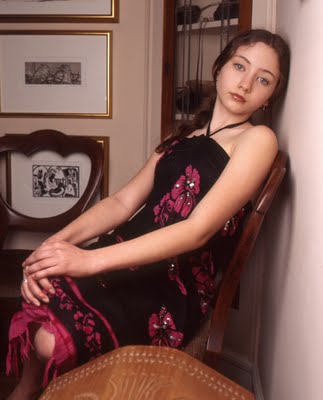
Yesterday, Saturday was a preview of things to come. Rebecca brought her well-mannered friend Jessica. We took the three girls (including Lauren) to Watermania in Richmond. Jessica and Rebecca played and chatted in the water. They cast their disapproving eyes on a young boy who was extremely overweight. At one point I asked Rebecca if she wanted to swim some lengths with me so she could practice her beautiful backstroke. Her, “No,” was predictable.
At age 67 one side of me objected at the idea of having to share my precocious granddaughter with her friend. But I also understood that this was the way it had to be and perhaps some day in the not so near future I might again have a relationship with my granddaughter that will be mature as we explore cultural events together.
I watched Lauren in the wave pool. She is now not in the least afraid of the water. She has developed a self-confidence reflected by a wide smile as she navigated the deep end in a foam float. She would fall off every once in a while but there was no panic in her face. It was comforting to see her as it was to see Rosemary hovering around and keeping a watch.
Last night I caught Rebecca using her hands to pick up the shredded Parmesan to put on her gnocchi. “There is a spoon for that! I am shocked at your manners,” I told her, in the presence of her friend. Rebecca's wise mother turned to tell me, “There are times when you should not pursue a battle. This is one such time.”
Over There
Faith Healing and the Original Hot Dog
By Mati Laansoo
Illustration by Marv Newland
Vancouver Magazine, March 1982
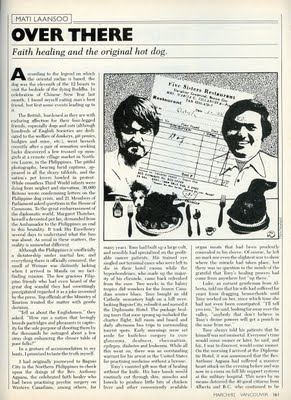
According to the legend on which the original zodiac is based, the dog was the eleventh of the 12 beasts to visit the bedside of the dying Buddha. In celebration of Chinese New Year last month, I found myself eating man’s best friend; but first some events leading up to it.
The British burdened as they are with enduring affectin for their four-legged friends, especial dogs and cats (although hundreds of English Societies are dedicated to the welfare of donkeys, pit ponies, budgies and mice, etc.), went berserk recently after a pair of sensation seeking hacks discovered a few trussed up mongrels at a remote village market in Northern Luzon, in the Philippines. The pitiful photographs, bearing lurid captions, appeared in the sleazy tabloids, and the nation’s pet lovers howled in protest. While countless Third World infants were dying from neglect and starvation, 30,000 Britons wrote condemning letters on the Philippine dog crisis, and 21 Members of Parliament asked questions in the House of Commons. To the great embarrassment of the diplomatic world, Margaret Thatcher, herself a devoted pet fan, demanded from the Ambassador to the Philippines and end to this brutality. It took His Excellency several days to understand what the fuss was about. As usual in these matters, the reality is somewhat different.
Although the Philippines is unofficially a dictatorship under martial law, and everything there is officially censored, the smell of Weimar was distinctly lacking when I arrived in Manila on my fact-finding mission. The few gracious Filipino friends who had even heard of the great dog scandal they had unwittingly precipitated regarded it as a joke invented by the press. Top officials of the Ministry of Tourism treated the matter with gentle derision.
“Tell us about the Englishmen,” they asked. “How can a nation that lovingly breeds partridges and pheasants in captivity for the sole purpose of shooting them by the thousands be outraged about a few stray dogs enhancing the dinner table of poor folks? ”
In a gesture of accommodations to my hosts, I promised to taste the truth myself.
I had originally journeyd to Baguio City in the Northern Philippines to check upon the doings of the Reverend Anthony Agpaoa, the celebrated faith healer who had been practicing psychic surgery on Western Canadians, among others, for many years. Tony had built up a large cult, and sensibly specialized on the profitable cancer patients. His trained eye singled out terminal cases who were left to die in their hotel rooms while the hypochondriacs, who made up the majority of his clientele, came back refreshed from the cure. Two weeks in the balmy tropics did wonders for the frozen Canadian winter blues. Tony bought and old Catholic monastery high on a hill overlooking Baguio City, rebuilt it and named it the Diplomatic Hotel. The package healing tours that soon sprang up included the charter flight, full room and board and daily afternoon trips to surrounding tourist spots. Early mornings were set aside for knifeless surgery to cure glaucoma, deafness, rheumatism, epilepsy, diabetes and leukemia. While all this went on, there was an outstanding warrant for his arrest in the United States for practising medicine without a license.
Tony’s vaunted gift was that of healing without the knife. His bare hands would routinely cut through skin, muscles and bowels to produce little bits of chicken liver and other conveniently available organ meats that had been prudently concealed in his sleeve. Of course, he left no mark nor even the slightest scar to show where the miracle had taken place, but there was no question in the minds of the grateful that Tony’s healing powers had come from anywhere but “up there.”
Tony always told his patients that he himself was not immortal. Everyone’s time would come sooner or later, he said and his, I was to discover, would come sooner. On the morning that I arrived at the Diplomatic Hotel, it was announced that the Rev. Anthony Agpaoa had suffered a massive heart attack on the evening before and was now in a coma on full life support systems at the military hospital. This news by no means deterred the 40 good citizens from Alberta and B.C. who continued to be operated on by four assistant healers, suspicious looking youngsters in T-shirts and Adidas runners who bore an uncanny resemblance to Manila cab drivers.
But back to the main story: man eats dog. The morning’s doings at the Diplomatic having left me somewhat puckish, my guide drove me to the Five Sisters Restaurant of the Slaughterhouse Compound. There I met the jovial proprietress Mrs. Marcia C. Villaneuve, a locally celebrated cook. The restaurant was empty except for a lone Jeepney driver eating his daily dog, and a quiet foursome dining on a mixed menu that included the house specialty. I learned from Mrs. Villaneuve that in the remote barrios of the Philippines, where the average income is less than $5 a week, homeless mongrels are sometimes sold for food instead of being gassed to death by the SPCA. She went on to point out that “fragrant meat,” as the Chinese call it, is considered a delicacy only when the diners know that it is dog they are eating.
I ordered a round of San Miguel beer for the Five Sister’s lunchtime patrons and a plate of canine casserole for me and my guide. The dish arrived promptly, a rather nondescript gray in appearance, its gravy dotted with a few bay leaves. The taste was very much like some of the better Chinese meat dishes done in garlic and black bean sauce: a bit chewy, somewhat spicy and vaguely redolent of pigs’ trotters with all the little leg bones and knuckle joints to crush on. Appearances notwithstanding, it was very tasty, and arguably good value at 10 Pesos, or $1.35.
Of course, I complimented Mrs. Villaneuve on the delicacy of her dish, and she in turn beamed her approval and suggested that I pass on the recipe for culinary adventurers overseas. The carcass she said, should be skinned and hanged by a competent butcher, after which the choice meat should be cut into bite-sized pieces and cooked in rice vinegar for a very long time until it becomes “al dente.” After that, the meat is salted and simmered in a broth of oil, garlic, bay leaf and pepper, with a dash of monosodium glutamate to bring out the bouquet. It is then served piping hot in its own rich gravy, with a side order of fried noodle and sliced green mangoes. All cultural impediments aside, the dish (as many early European navigators in the region have testified) is delicious, although like the barnyard chicken who has become familiar enough to have earned a name, likely less so if you happen to have known the dish wagging its tail earlier.
I confess that after my Philippine luncheon I now look at my canine friends with renewed respect, and rather suspect that that the feeling is mutual. These days, whenever I meet dogs fooling around in the street or being tedious at the pub, I just point my finger at them, like Charles Bronson in Death Wish, and they smarten up real quick, because they know.

Some of you might suspect that I am running out of ideas and inspiration to write my daily blog and that I am getting ready to shelve the now four-year-plus project. This would be far from the truth as I have no problem in drumming up stuff to put up here. If anything one of my problems is to stop my desire for multiple blogs in one day. This is a rare example of one.
So why is it that I am resorting to pulling a Lazarus on articles written many years ago by writers that I admired who worked for the magazine, Vancouver Magazine, run by Mac (a.k.a Malcolm ) Parry? You might suspect that to anybody my age (67) the past will always be rosier and better. In fact I would not agree with you. So much stuff nowadays is so much better.
When we arrived to Vancouver in 1975 the city’s bread was a distinct but nondescript variety of cardboard. I longed for the bolillos of Mexico and the handmade corn tortillas. But it has all changed. Even Safeway now bakes a credible croissant and a three-cheese focaccia. My wife’s Sony clock radio (with a CD player) sounds better than some of my early stereo systems of of rosy yesteryear. The plastic housing of modern lenses might not have the heft or the feel of my old Takumars and Nikkors but their computer designed optics surpasses my old clunkers in performance. And to end all arguments about that rose and better past what would be your old-fashioned equivalent to modern Viagra?
Nevertheless I don’t completely accept that the present is better than the past. My granddaughter Rebecca refuses to use my mother’s cook books. She will not consult Mary Lou Glass’s Recipe for Two (1947), Rombauer/ Becker, The Joy of Cooking (1953 Edition) or Marion Brown’s The Southern Cook Book (1968). But although she says that the recipes she finds on the internet are better because they are more modern she will have several helpings of Adalyn Lindley’s Chicken a la Barbara from the latter Southern Cook Book when I prepare it for some of our Saturday dinners.
What these stories and essays from the past do prove is that during Mac Parry’s stewardship of Vancouver Magazine from April 1974 to December 1988 we had a lively, intimate, warm, interesting, challenging city magazine that was visually arresting with many illustrators and photographers who contributed. The magazine had a policy of monthly “piss-ups” where contributors would feast on terrible chips and cheap raw-tasting Portuguese Vinho Verde or beer. Writers, illustrators and photographers would compare notes and ideas would spring from these for future issues of the magazine.
It was Mati Laansoo (who is not ashamed to admit to have eaten dog), an Estonian writer with Texan tendencies to collect small arms and store them under his pillow who recently told me, “Mac was like William Shawn. He liked to surround himself with a variety of good writers, and illustrators and he encouraged them to give their all.”
It was Mac Parry who first instigated me to write my first piece on my experiences as a sailor in the Argentine Navy. I remember a young man who came in one day with slides of people wearing Hawaii T-shirts. He ran a piece on that subject a few months later. One of the pictures featured a Santa Claus attached to two scantily clad (tiny T-shirts) in Hawaii which elicited hate mail a few hours after the magazine hit the stands.
This was indeed the case when Laansoo’s Over There hit the March 1982 stands. There were letters and furious phone calls from pet lovers.
I remember that March 1982 very well. A month before Mac had taken me to the Cecil Hotel for a beer and told me, “Sean Rossiter has written a piece about his cat. It has cancer. I want you to go home and photograph your cat and make sure its whiskers are sharp. But I did not only have the cover. I also had some interesting pictures for a piece written by Les Wiseman.
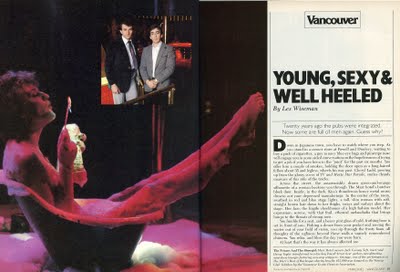
At the time writer Les Wiseman and were avid followers of the descendants of Salome and we came up with a ploy to convince Mac that it was worth a feature. We convinced him on the business side of exotic dancing.
I think that in 1982 Mac had skillfully managed to keep his independence as an editor from the hands of our publisher Ronald Stern. It seemed like Mac could run articles about nonsense (such as the piece by Ben Metcalfe in this blog a few days past) or wild dogs in Iran and Stern would not protest about these stories not having the substance to attract advertisers to the magazine’s pages. In fact Mac came up with the idea for running two different covers that March. One was to feature the cat and the other a stripper. It would have been an experiment that would have preceded Chicago Magazine’s run a few years later featuring the city’s mayor smiling in one batch and serious in another. Stern quashed the plan and I never had to test the waters of demanding a double cover pay!
The illustration to Laansoo’s piece is by our very own famous illustrator and animator Marv Newland. I suspect that he used a cheap copier type technology to come up with the concept. He did confirm with me (yesterday) that Laansoo did indeed provide him with the restaurant’s bill of sale as proof. In the illustration, the man on the left is Mati Laansoo. The man on the right (described as “my guide”) by Laansoo is Gary Marchant. Marchant wrote what is considered to be one of the best travel columns ever, anywhere, called Faraway Places for Vancouver Magazine.
I remember with great fun the day that Marchant told me a story of traveling through some remote African country (it could have been Chad). He arrived at a small town exhausted and hungry. He inspected the large pot simmering over a fire at his little hotel. He spotted some bones in the stew. The cook gestured with his arms to represent a bird so Marchant assumed the stew was chicken or some similar fowl. He helped himself to a large portion. He was licking his chops when he spotted a little horrific skull staring at him. It was the little head of a bat.
Perhaps my past, or at least my past as a magazine photographer was a rosier one. Perhaps the present with the universal and all-encompassing presence of the net has made those magazines of my era irrelevant. My friend Mark Budgen says I am sentimentalizing it. My friend John Lekich says that those magazines had heart and the present ones don’t. You who read this can be impartial judges.
As for me I remember my grandmother’s words, “Nadie te quita lo bailado.” Nobody can take away from you the pleasures you had. And many pleasures I had reading the stories of Lansoo, Wiseman, Lekich, Marchant, Hunter (Bob), Metcalfe and many others who all wrote from the heart.
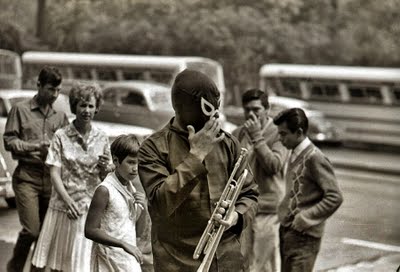
I divide the people that populate our world in two. There are people who throw dishes in anger and those who don’t. I am from the first category.
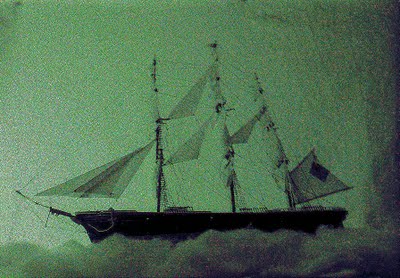
On Sunday Rebecca stamped her feet and started yelling how she hated making pie crust. She showed it to me and told me, “It’s too hard. Something did not happen right.” And she promptly threw it into the kitchen trash can and stormed off.
At age 12 we are all saying that Rebecca is at that point in her life where she is about to become a woman in body while the mind is not quite there yet. I am not all that sure of this.
In 1957 I took this picture of my Revell replica plastic kit model S.S. Constitution (Old Ironsides) with an Agfa Silette. I placed my finished ship on a bed of cotton. The picture is not all that sharp. I have played around with Photoshop here to make it look like a fake late 19th century photo.
My S.S. Constitution survived with many other models I built (cars, airplanes, ships and tanks) so that when I became a late teenager I gave them all away to my cousins, the Forments. There were several models that did not survive. One I remember well was H.M.S. Bounty. I was carefully applying the rigging (black thread) with tweezers when something just did not occur to my liking. I screamed. I got up. I threw the ship to the floor and then I jumped on it. My mother was all upset and almost in tears. I never quite outgrew these fits of destructive temper although I must confess here that when I am about to throw something I always weigh its value as opposed to its immediate need in my life. It might take a short second but I always think it first.
I had been considered a gifted painter and drawer since I was 5 and by the time I was 10 I had been given many lessons. It was about then that I would become frustrated with an attempt to paint this or that that I would pick up my work in progress and tear it up as loudly as I could. At age 14 I suddenly and finally stopped painting. I received my last paliza (whipping) from my mother as punishment for my artistic block.
My wife Rosemary, at first, like my mother did not know how to deal with my fits of temper. She would tell me to stop while screaming or crying. This always made it worse as I had an audience. In our early years of marriage most of the beautiful tea cups (some were Noritake or Wedgwood) went flying across the kitchen narrowly missing my distraught Rosemary. Here are two cups (the upper one is Wedgwood, and the lower Noritake) that survived my china onslaught.
It took a while but Rosemary figured it out. She stopped being my audience and ignored my outbursts. These outbursts were almost always followed by intensely powerful migraines. My intelligent Rosemary gave me no comfort. It was sometime about 10 years ago when my weekly migraines suddenly ceased and I have not broken anything for years.
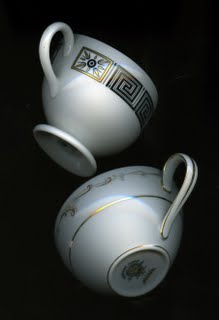
I observe in Rebecca something of myself. I am going to see if I can approach her with logic and explain how I was and how I regret the destruction of my H.M.S. Bounty. I have told her that anger and temper are never an excuse for rudeness. I think I will give her as a gift my two cups (I do have the saucers as Rosemary must have hidden them during one of my tantrums) and perhaps they will serve her as a guide to controlling her temper.
Ever patient and low key Rosemary removed the pie crust from the trash can and rolled it out and lined a Pyrex pie plate. Rebecca was furious but she calmed down enough to say, “I will finish it.” This she did. She followed the recipe blindly and added the full count of sugar. The pie was too sweet. She was furious and refused to take a few slices home for her father.
Just a few minutes before I started this I helped myself to the last slice of Rebecca’s blueberry cream pie. It may have been a tad sweet but thank God for women like my Rosemary.
Lolita, light of my life, fire of my loins. My sin, my soul. Lo-lee-ta: the tip of the tongue taking a trip of three steps down the palate to tap, at three on the teeth. Lo. Lee. Ta.
She was Lo, plain Lo, in the morning, standing four feet ten in one sock. She was Lola in slacks. She was Dolly at school. She was Dolores on the dotted line. But in my arms she was always Lolita.
Chapter 1, Lolita by Vladimir Nabokov
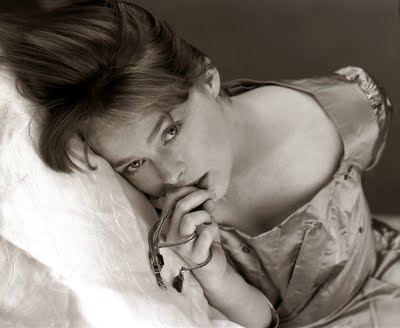
Some months back I took my two granddaughters to an Arts Club production of a musical called Nevermore: The Imaginary Life and Mysterious Death of Edgar Allan Poe. Even Lauren who is 8 managed to enjoy the musical play. She liked the costumes which resembled a modern Goth version of Alice in Wonderland. Rebecca had many questions on Edgar Allan Poe so I read The Telltale Heart to her after dinner. I did not do as a good a job as Iggy Pop and she found Poe a bit on the dull and repulsive side. She thought the Vincent Price version of The Fall of the House of Usher, renamed The House of Usher was cheesy. But at age 12 she knows more about Poe than the average 12-year-old and perhaps Poe might grow on her in the future.
My interest in Edgar Allan Poe began in 1957 when one of my English teacher Brothers of the Holy Cross at St Ed’s High School in Austin, Texas played a record in class. It was James Mason narrating Poe’s Annabel Lee. It was only a few weeks ago that I found the recording on one web page and as par for the course in this day and age of Google there is no information on date and record label. In fact my searches have taken me nowhere.
But I have a vivid memory of that recording but not vivid enough to remember that the recording had music in the background.
Thanks to James Mason I became a lifelong fan of all things Poe. I have read everything Poe wrote.
Of late I have read books in which Poe is a character such as in Matthew Pearl’s The Poe Shadow and Louis Bayard’s Pale Blue Eyes. The former is an extremely convoluted novel and the latter a bit more satisfying in which Poe, as a young cadet in West Point, assists a famous investigator after several brutal murders occur at the school.
I also liked Laura Lippman’s In A Strange City, 2001 (a novel in her series in which the main protagonist is a young female journalist-turned-nvestigator who lives in Baltimore, where Poe died and is buried). The novel centres around the well-known Baltimore ritual: Every year, on Edgar Allan Poe's birthday, a mysterious figure visits the writer's grave, leaving behind three roses and a bottle of cognac. When Tess gets wind of a plot to unmask the so-called Poe Toaster, she decides to stand guard. To her amazement, two visitors approach -- and one is shot and killed.
Some reader’s might know that for the first time ever the Poe Toaster did not show up this year on January 19.
I enjoyed a the 1951 film The Man With the Cloak (based on a short story, The Gentleman in Paris, by John Dickson Carr) with Joseph Cotten, Barbara Stanwyck, Leslie Caron and Louis Calhern. Cotton plays a failed poet called Dupin (!).At the end of the film, when Madeline (! The Fall of the House of Usher), played by Leslie Caron, goes looking for Dupin at a bar to thank him for a service rendered. Dupin's generous bartender Flaherty (Jim Backus) tells her he has gone, leaving only a seemingly worthless IOU for his sizable bar bill. On one side is a draft of a verse about a woman named Annabel Lee and the IOU's signature, which reveals Dupin's real name: Edgar Allan Poe.
While researching a bit of Poe to explain to Rebecca, I found out the hitherto (for me!) connection between Edgar Allan Poe and Vladimir Nabokov. It seems that the novel (published in Paris in 1955) was going to be originally called A Kingdom by the Sea. Humbert Humbert’s first love (unconsummated) is a young girl called Annabel Leigh.
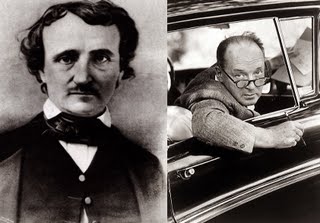
This has led me to be currently reading The Annotated Lolita, Edited and with a preface by Alfred Appel, Jr. Two bookmarks are compulsory equipment here to keep track of all the footnotes, explanations, parody, coincidences (probably all intentional on the part of Nabokov) of this annotated version.
This Lolita came to me via former Vancouver Magazine associate editor (“Rock’roll died after the Beatles.”) and Nabokov scholar, Don Stanley. Three weeks ago the door bell rang at 8 in the evening. I opened the door to Don Stanley and wife. He said, “I have something for you,” and handed me the annotated version of Lolita.
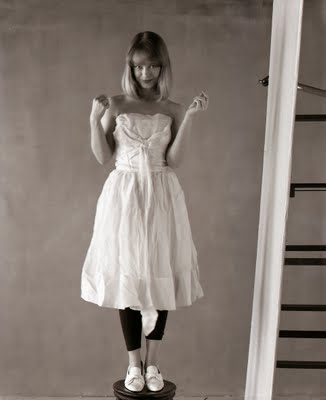
One mystery remains for me. Since we know Nabokov published Lolita in 1955 (Olympia Press, Paris). When did James Mason record his reading of Poe’s Annabel Lee? Was the recording a possible reason Mason was chosen for the role of Humbert Humbert in Kubrick’s film Lolita in 1962? Or was it all Nabokovian coincidence?
The stand-in for Lolita here is Vancouver actress and mother of two, Corrie Clark. Clark recently conveyed to me the following:
These days I am working hard on screenwriting, among the days of motherhood. I am currently writing a screenplay about Emily Carr and again, ironically her
relationship as a 'surrogate mother' to a little girl who eventually lived with her for a few years when she was ...yes, 12.
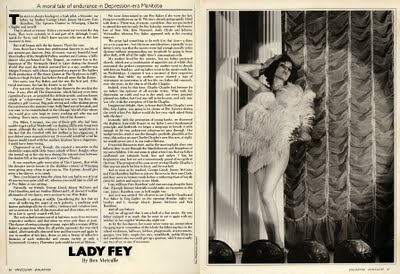
A moral tale of endurance in Depression-era Manitoba
by Ben Metcalfe
This story is about a fan dancer, a bush pilot, a Mountie, my father, my brother, George Lloyd, Jimmy McGuire, Fats Hamilton, the Uptown Theatre in Winnipeg, Charlie Chaplin and myself.
That is about everyone. Unless you want me to count the dog team. They were certainly in it and part of it, although I can’t speak for them, and I don’t know anyone who can at this late moment in time.
But it all began with the fan dancer. That’s for sure.
Now, there have been four professional dancers in my life of any account qua dancer. One, of course was my beautiful Aunt Vera Dudley of the Ziegfield Follies; another was Carioca, a belly dancer who performed a the Dugout, an esoteric bar in the basement of the Metropole Hotel in Cairo during the Second World War until the British arrested her as a spy; another was Margot Fonteyn, with whom I appeared as a super in The Sadlers Wells production of The Snow Queen at the Orpheum in 1957, thanks to Hugh Pickett; but before them all came the fan dancer.
Her name was Fey Baker, and she was the first, and if the trend continues, the last fan dancer in my life.
Fey was not, of course, the only fan dancer in the world at the time. It was, after all, The Depression, which had not even been capitalized as yet, or accorded the definite article, and was known simply as “a depression.” Fan dancing was a very big then, like miniature golf courses, flag pole sitting and roller skating across the continent in the summer time. Sally Rand was at her peak, and very soon to be immortalized at the Chicago World’s Fair where she would give new hope to every working girl who was not working. There were, consequently, lots of fan dancers.
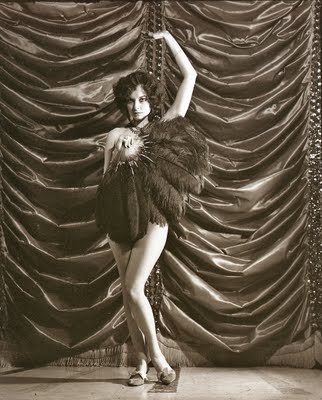
Fey Baker, I suspect, was one of those girls who had been unable to get a job at Woolworth’s or dealing off the arm in a greasy spoon, although the only evidence I have for her neophytism is the fact that she traveled with her mother as her chaperone. It just did not seem reasonable to my 13-year-old mind that a real fan dancer would travel with her mother, let alone have a chaperone. I could have been wrong.
Chaperoned or not, though, she created a sensation in the clerkishly respectable little inner suburb of River Heights when she turned up as the star turn during the intermission between the double bill at the garishly new Uptown Theater.
It was somehow aptly innovative of The Uptown, that while the cheaper movie houses in the shabbier corners of Winnipeg were giving away china to get you in. The Uptown should give you a fan dancer, so to speak.
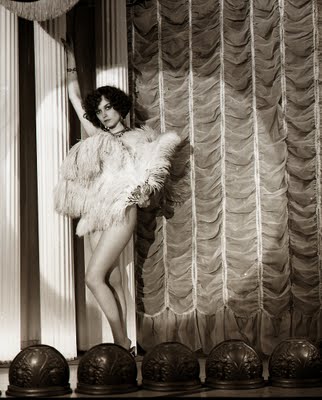
True, you did get to keep the china, but you had to see at least 48 movies to acquire a full set, whereas you could take in a full set of Fey Baker at one sitting.
Naturally, my friends, George Lloyd, Jimmy McGuire and Fats Hamilton, and my brother Robert and I, all devout if sudden aficionados of the dance, were anxious to see Miss Baker.
Naturally is putting it mildly. Considering that we were all suffering the angst of early puberty, a condition well known pathologically for its virility, virulence and voraciousness, not to mention its lack of discrimination and discretion, we were, let us face it, openly crazed with lust.
The only naked woman any of us had seen in our lives were our respective mothers, and that when we were only three at most. The chance of seeing a strange woman, especially a woman of Miss Baker’s proportions when (by all public accounts) she was stark naked, albeit tactically obscures here and there now and again by one or another of her fans, drove us into a frenzy of collective fantasies of such recherché and rococo variety as only a Seventeenth Century Florentine jade could invent ad libitum.
We were determined to see Fey Baker if she were the last thing we would see on earth. We were already going rapidly blind with desire. There was, of course, a problem. One was permitted to attend the movies only for the Saturday matinee’s wholesome fare of Tom Mix, Ken Maynard, Andy Clyde and Johnny Weismuller, whereas Fey Baker appeared only in the evening séances.
The price had something to do with it in that time - a dime vis-a-vis a quarter – but the main consideration, especially in my father’s view, was that the movies were bad enough morally in the daytime without compounding our turpitude by going to them after dark, with all the night-time’s concomitant evils.
My mother lived for the movies, but my father preferred church, which was a combination of opposites out of which they concocted the perfect compromise: my mother went to church with him on Sundays, and my father went to the movies with her on Wednesdays. I suppose it was a measure of their respective devotion that, while my mother never showed a sign of repentance or conversion in all her life, my father did succumb, over the years to the charms of Charlie Chaplin.
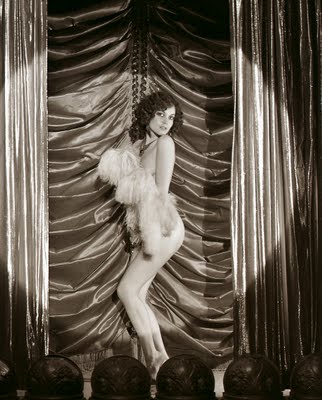
Indeed, even by this time, Charlie Chaplin had become for my father the epitome of all secular virtue. What with the depression on earth and war in the wind, not every prospect pleased my father, but God was still in his heaven, and only man was vile, with the exception of Charlie Chaplin.
Imagine our delight, then, to learn that Charlie Chaplin’s new film, City Lights, was going to be shown at The Uptown during the week when Fey Baker would do her own stark naked thing with the fans!
Instantly, with the perception of young hawks, we discerned the slightest, hair-wide fissure in my father’s most fundamental principle, and forthwith we began a campaign to breach it wide enough to let two pubescent voluptuaries pass through. Our wedge into his resolve was the thought, perfectly plausible at the time, that unless we saw Charlie Chaplin’s new film now, at night, we would never see it in our entire lifetime.
From this distance in time, and in the taunting light of my own failures later to see through the blandishments and deceptions of my own children, I do not mean to gloat when I say that my father swallowed our rationale hook, line and sinker. I beg his forgiveness now, but we were uncommonly proud of our guile at the time. The prospect of his sons never seeing Charlie Chaplin’s film was too much for him to bear, and he cracked.
And as soon as he cracked, George Lloyd, Jimmy McGuire and Fats Hamilton had but to convey the news to their own Dads, and they were as broken reeds before a withering blast of boyish pleas for justice and equity in our block.
I can still hear Fats Hamilton’s old man musing along the lines that, if Joseph Bennet Betcalfe would make an exception in this case, James Hamilton sure as hell might, too.
And so it was settled. We all went to see Charlie Chaplin and Fey Baker in City Lights on the opening Monday night: my brother and I, George Lloyd, Jimmy McGuire and Fats Hamilton.
And all our fathers.
And we all agreed it was a hell of a fine movie. My own father enjoyed it so much that he went to see it again with my mother on her regular Wednesday night out.
As for the fan dancer, her name never came up, except when the gang was in a committee of the whole the following days in the school washroom, hallways, lobbies, playgrounds, street corners, garages, tree forts, empty box cars, woodsheds, public libraries and anywhere else we could get up a quorum, which was usually any two of us, or one if necessary.
From one meeting to the next, it was moved, seconded and carried that Miss Baker had revealed more and more and more of her most intimate body to our committee than she had shown advertently or inadvertently to anyone.
Within a matter of days, in fact, it became clear to us all that she might as well have left her mother the chaperone at home, for all the good she did, and her fans to boot, for all they concealed of her flesh. Very soon, then, we realized that she had singled us out in the front row, where we had persuaded our fathers that we could see City Lights better, and had been making desperately lewd attempts to get us to go home with her after the show.
If one of us forgot momentarily some particular suggestive gesture on her part, or some interesting detail of her body, like a hair or an unusual coloration of the flesh in some out-of-the-way crevice, another would remind him of it without the slightest disjunction of continuity either in theory or in practice.’
The Uptown held her over for two weeks, but although she left town, we held her over as long as we could in our committee meetings until something better turned up, which it did not.
And then the big story broke…
The first I knew of it was from my father mumbling, “Well what do you know about that? “ and shaking his head reflectively as he passed The Winnipeg Tribune to my mother over their after-supper cup of tea.
“Hmmmmmppphhh,” said my mother, after reading the headline and passing the paper back to my father. My mother never read more than the headlines, and then only at my father’s suggestion. Usually, he would read the entire edition, from the front page disasters to the back page horoscopes, then fold it up and put it down with the comment that there was nothing in the paper again. My mother knew that he was keeping an eye out for the Four Horsemen of the Apocalypse and would let her know in plenty of time it they should turn up at Portage & main. Meanwhile, she relaxed, or worried about whether Clark Gable was suited to Carol Lombard.
This unusually sanguine attitude of my father to a piece of news did, however, arouse my own curiosity, and I turned my attention from my homework to the front page where the main headline screamed out in black letters the size of boxcars:
FAN DANCER & BUSH PILOT
DOWN IN NORTHERN BLIZZARD
Yes, it was none other than our own Fey Baker, who had gone north from her Winnipeg engagements to entertain the miners in the then-new frontier mining town of Flin Flon.
On the flight back, the plane had disappeared, and was long overdue.
Now, whereas the Fey Baker fantasy had been held over, as I say, by our committee as long as it was feasible, it had been receding and becoming vaguely blurred and generalized quite naturally before the onslaught of the Stanley Cup play-offs and the careers of the brothers Conacher, etcetera.
The news of Miss Baker’s plight jolted us back to fantasy.
Without much delay, our committee met the next day in every possible nook and cranny of school and neighborhood to review this revitalizing turn of events, to concoct and embellish new scenarios and to take turns to play the role of bush pilot, whose luck we could not entirely believe.
The fact that the fan dancer and her escort were lost in a mean temperature of some fifty below zero did not chill our imagination. Indeed, our imagination was too preoccupied even to think if about providing Miss Baker with anything warmer than her fans. How she endured, I have no idea.
A fan dancer lost in the wilderness with a bush pilot! How can you impossibly improve on a story like that?
Well you cold send a Mountie out to look for them with a team of sleigh dogs, couldn’t you?
You certainly could, and they certainly did, and the ensuing tension was even more exquisitely unbearable.
Hitler was taking over Germany from Field Marshall Hindenburg. Mussolini was preparing to seize the entire Mediterranean Sea, Britain was going off the gold standard, Dillinger was shooting up the United States, Roosevelt was launching his New Deal, the Liberal Party of Canada had been given a well-earned rest from power by the conservative Janitorial Party, and Japan was moving into China.
But not as far as our committee was concerned. For us there was only one current event: Topic A.
Unaccustomed as we were to reading more than the funnies and the hockey scores, we were now unconscionably interested in the front pages of the daily press insofar as they informed us the progress of the search for the fan dancer and her bush pilot and, as was bound to happen, the Mountie, too. Because, soon, enough, all three were lost, and apart from everything else, this created complications in our committee.
We did not quite know, in our mid-western simplicity, how you handle this kind of ménage à trois. If we had even heard of a ménage à trois.
The best we could come up with was that the bush pilot and the Mountie would simply have to take turns being in love with the fan dancer, while the fan dancer would simply have to be in love with whomever stayed in the cabin (we eventually built them a cabin, but Miss Baker still naked) while the other one went out to hunt for food and chop firewood.
There was a certain reluctance for a long time, too, for many of us to become the Mountie. Not that we had anything against Mounties at the time. It was just that we had all got so comfortable in the role of the bush pilot.
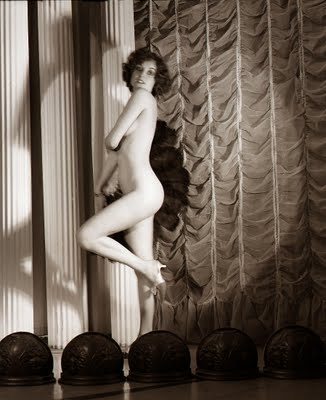
Meanwhile, the search went on. And, eventually, of course, the most publically exposed ménage à trois in Canadian history was found and brought back to civilization, where, as they returned, there was a great deal of public speculation as to whether Fey Baker would marry the bush pilot or the Mountie,
It was written into the manners and the mores of that place and time that no girl, fan dancer or not, could spend so long in the bush with two men without marrying one of them very soon.
My mother, who was a follower of such things as Rose Marie in real life, figured it would be the Mountie who got the girl. But my father pointed out that it would have to be the bush pilot, because the Mountie was under marrying age according to the prevailing stringencies of the Force. And there the matter ended as far as my parents were concerned
As for our committee, we continued to raise the matter for speculation some time after it had dropped by society as a whole.
We dallied, briefly, over the rumor that the sleigh dogs had suffered badly in the event, having been eaten by the Mountie the bush pilot and maybe even the fan dancer, too, just to keep up their strength in the rigors of the Manitoba winter. But this was never established incontrovertibly, though it has a plausible enough ring to it.
Life eventually resumed its everyday course. George Lloyd became and anti-submarine bomber pilot in the RCAF, and survived to retire and play golf; Jimmy McGuire was shot down and killed over the North Sea as an air gunner with the RCAF; Fats Hamilton has been trying to console his parents for the loss of his brother Jim, with the Seaforth Highlanders; all our Dads are gone, of course. The Uptown Theater is now a bowling alley; and you know what happened to Charlie Chaplin, apropos which I must confess to the shades of those Dads that we did, in the event, get a number of other chances to see City Lights, although we had no way of predicting Television then. And, anyway, I have since figured that we are quits, seeing as how we helped them get to see the fan dancer, too.
Maybe the bush pilot and the Mountie are still around and will come forward to sue me, and they are most welcome. There’s a couple of things I would like to ask them.
As for the fan dancer, I never heard of her again, but I can say fondly and sincerely now, as Jimmy Durante might have said, “Good night, Miss Baker, wherever you are.”
And with Browning, “How did we love you? Let me count the ways. “
First published in the January 1980 Vancouver Magazine
Behind Lady Fey
The photograph that appeared in the January 1980 issue of Vancouver Magazine which was used to illustrate one of my favourite pieces ever written by anybody (in this case by my friend, E. Bennet Metcalfe) has an interesting story on how it came about.
In the late 70s and early 80s Vancouver Magazine was a Mecca for the best editorial illustrators of the city and the country. These were Marv Newland, Brent Boates, Ian McLeod, Ian Bateson, Barb Wood, Bernie Lyon and more that I cannot remember.
In my presence (probably an editorial gaffe as I should not have been privy to the conversation) art director Rick Staehling proposed Metcalfe’s piece should be illustrated while the editor, Malcolm Parry argued for a photograph. Lucky for me Parry prevailed and I was assigned to shoot it.
I chose a gay review club on West Pender Street called BJ’s because they had an old fashioned type stage and a spotlight. As my subject I chose my blood sucking friend Inga V who was an experienced dancer with and sans fans. Plus she had the added talent of being a makeup artist and stylist. I don't remember where we obtained the feathers. They probably had them in the costume department of BJ's.
I have always been proud of my ability to shoot well-exposed and sharp photographs. For the first time (and last) I saw myself focusing and then unfocusing my lens a tad, to get and old-photograph blurred look. I helped this along by using a slow shutter which might have been 1/15 second or slower.

From the moment that I can remember being an individual I can remember my mother opening a heavy but small jewel box and showing me the heart of diamonds. Of all the jewels (purchased in Paris) that my grandfather Tirso de Irureta Goyena had showered on his bride and wife my grandmother Dolores Reyes de Irureta Goyena the only one that was left was the little quartz heart studded with diamonds. The rest of the jewels had been pawned off or sold to finance the divorces of my uncles and aunt.
When Alexandra Elizabeth (our first daughter was born in 1968) my mother told me that it was her will that the heart would be used to finance Alexandra’s university education. “I want her to have all the opportunities she deserves,” she told me.
Both Ale and Hilary managed to graduate from university here in Vancouver. Ale went to UBC and Hilary to Simon Fraser. What is to happen to that little heart of diamonds? I would think that my mother’s will, would transfer to our eldest granddaughter. We shall see and keep the little heart in its box.
Fulfilling the wills and desires of someone who is dead is something that most of us take most seriously.
I never thought that I would have to do this for someone else.
It was this past July that my friend Abraham Rogatnick shocked me with a statement that I first took lightly. He said, “If there is anything I want to do before I die is to go public on my stance that the Vancouver Art Gallery should stay put.” He wrote up his reasons and went to visit Vision Councellor Heather Deal. Deal red the “manifesto” and said something like, “Let’s wait and see.” Rogatnick told me, “I lost it and I yelled at her, what do you mean you are going to wait and see?”
I told Rogatnick to give me his manifesto and that I would try to see if anybody was interested. By mid August Rogatnick was ailing and I told him I had been unsuccessful in my efforts to get the radio, TV, web based magazines and our local newspapers interested. Rogatnick simply told me, “You tried.”
This past Monday I can say now that thanks to the intersession of the Vancouver Sun’s city columnist, Miro Cernetig, Rogatnick’s manifesto is up in today’s Vancouver Sun editorial page.
Rogatnick did not believe he was going anywhere when he died at the end of August of last year. I felt I had let the man down.
But Rogatnick was always pragmatic and he would probably agree with me that his manifesto might be that much more effective coming from the grave than when he was alive. My thanks to Miro Cernetig for keeping Rogatnick’s vision alive.
The Vancouver Art Gallery & The Boer War
Wednesday, March 10, 2010

While driving Monday morning to Rona to purchase shady garden grass seed for my garden, I turned on CBC Radio 1’s Almanac and listened to Kirk Williams. He is the provisional host while Mark Forsythe is on holidays. Williams introduced a man whose voice was a dead ringer for Archibald Alexander Leach. It was a smooth and urbane voice. I would vote for the auditory doppelgänger or buy a used Toyota from him.
The Cary Grant impersonator was Michael Audain OC OBC Chairman Polygon Homes Ltd., Chair of the Vancouver Art Gallery Foundation, the Audain Foundation for the Visual Arts, and the National Gallery of Canada and most important is Chair of the group involved in the project to move the VAG to Larwill Park across from the Queen Elizabeth Theatre. He was calm and fielded questions (most listeners who chipped into the program were against the move) very well. He even managed to answer (it sounded good, I am not sure he made sense) when a speaker enquired about the in-the-red situation of the current art gallery and the fact that they are reducing staff and shortening their hours to save money.
It is understood that since the Province of British Columbia (which owns the property) does not charge the VAG rent, the reason for the red ink has to be explored and reconciled with a sum that would be upwards of 250 million Canadian dollars to build a new facility in the proposed site of Larwill Park which is the city block to one side of the Queen Elizabeth Theatre.
Larwill Park was a temporary (I understand that from the records) site of the Greyhound Bus Station. Previous to that it had served as a military parade ground and troops that were going to be sent to the Boer war were mustered there.
In the last few weeks several troubling incidents re: our city, have been revealed by the Vancouver Sun, the Globe & Mail and Francis Bula in her blog.
1. Under the mayorship of Philip Owen a deal was struck where the Vancouver Park Board sold Larwill Park to the City's Property Endowment Fund so that the Board could buy land along the Fraser River.
2. Subsequently we have found out that an office tower might be built in Larwill Park as a quid pro quo arrangement whereupon as Francis Bula writes in her blog(fragment of it in paragraph below)
The latest complication I discovered on Friday was that the city has already committed to using $48 million of the development profits from the site (most if not all of them) to pay for the QE Theatre renovation that happened in the past couple of years. More details on this confusing tale [in the Globe & Mail] here.
3. An article in the Tuesday Vancouver Sun written by Jonathan Ross explains why so much stuff happens in our city behind closed doors. It seems that many important decisions are made by our city bureaucrats and not by our elected officials.
4. Max Wyman told me he was privy some years ago to a meeting at the VAG that proposed the idea of incorporating the parts of the Simpson Sears building (designed by renowned international architect Cesar Pelli) with the VAG. An unnamed friend of mine said, “Douglas Coupland could place one of his airplane sized projects into that building with room to spare.” Wyman even told me that there were discussions involving he building of some sort of mechanical escalator between the VAG and Sears.
We (I) suspect that when Eaton’s had to vacate the site Cadillac Fairview (it leases the building from the city who owns the land) must have given Sears a sweet deal. But the sweet deal is not going to bring shoppers into a store that does not have a department that sells one of the Sears mainstays, Craftsman tools. I have to go all the way to Lougheed Highway to have my Craftsman lawnmower serviced. It would seem to me that if Sears could sublease part of the cavernous building, Sears, the VAG and we the citizens of this city would profit.
5. Miro Cernetig wrote an intelligent column on Monday on what is happening to our Robson Square Centre and particular in the light on how popular the location was during the 2010 Olympics.
To 5 I would add that I had several discussions on Robson Square with Arthur Erickson and my friend Abraham Rogatnick (who died in August 2009). It was our opinion that one of the biggest mistakes of our city was to bring in UBC to Robson Square.
The average person on the street is aware that Simon Fraser University is in town. Coincidentally he or she might even inform you that part of that downtown site on West Hastings was formerly a Sears store! I have attended countless seminars and lectures on urban affairs at SFU Downtown Campus.
How many people know that there is an important bookstore not far from Chapters on Robson and Howe? Few might know that UBC has a downtown campus in Robson Square and that the prestigious UBC Bookstore has a branch right there!
This general ignorance is that in my opinion UBC has botched its presence downtown. They have ill used the site and given it such a low profile that few know it exists.
In the past the Robson Media Centre (as it used to be called) had interesting cultural events in the premises and in particular in the Judge White Auditorium. It was in this auditorium whose sides had softly carpeted steps where some of us would slouch to listen to the likes of Arthur Erickson talk about our city. The auditorium was always full and I felt the richness of living with a city. I felt almost like an Athenian citizen of old.
What has happened to that auditorium? Is it used at all? This auditorium could be the very auditorium that Michael Audain says the VAG lacks.
It is my opinion (one I shared with Abraham Rogatnick) that UBC should vacate Robson Square and that it be taken over by the VAG.
In the photo above which I took for the Globe & Mail in 1997 that's, from left to right the then director of the gallery, Alf Boguski, curator Dana Augaitis and Michael Audain.
The Pleasures Of Editorial Collaboration
Tuesday, March 09, 2010

Quite a few years ago I was sharing my studio with another photographer. One day I walked into the studio to get a piece of lighting equipment and I found the photographer there. He asked me, “In a few minutes I have to photograph a woman called Carole Taylor (she was then a city Councillor) for the cover of Vancouver Magazine. Who is she?”
My friend and previous fellow collaborator Les Wiseman (he was the writer) for many a story for Vancouver Magazine and TV Guide told me that one of the secrets of good magazine writing is to research your subject. It would seem to me that this intelligent piece of advice also applies to photographers who shoot for magazines.
This advice has served me well. Researching my subjects has always enabled me to connect with the person facing my camera. Since many of these persons when shooting for magazines are some sort of celebrity or politician they usually don’t give you much time. You are forced to find a common ground of interest quickly if you hope to get a picture that will be different from all others. When I faced actress Helena Bonham Carter I knew her grandmother was Spanish. I had found this out through research. I had a suspicion Bonham Carter spoke Spanish. Taking her photograph, while in the presence of an intrusive writer who had brought his baby to the interview, I was able to bond with her when I spoke to her in Spanish. In fact Bonham Carter wrote me a letter in perfect grammatical Spanish thanking me for the fun she had.

With the slow demise of many magazines many of the procedures that once were in effect have faded. At one time writers and photographers worked in tandem. Wiseman and I went to many rock concerts together and interviewed musicians back stage or in their hotels. Wiseman sometimes advised me as to what his tack was going to be in the interview. I would tell him what my possible approach to the photograph would be. But what worked best was Wiseman’s insistence that I remain in the room during the interview. It was here that I got many of my ideas for that photographic approach. This policy of allowing me to remain during the interview was also a technique shared with writers John Lekich and Christopher Dafoe. Both of them worked for the Globe & Mail. The former wrote as freelance art reporter and the latter was the arts correspondent in Vancouver.

I have shot many magazine, tabloid and newspaper covers since 1975. I noticed something peculiar about some of my better covers. This is that sometimes they can only be used once, and only once. After that someone might ask,"So why that composite picture of Iggy Pop smiling?"
About 20 years ago I used to frequent the monthly meetings of an organization called CAPIC (Canadian Association of Photographers and Illustrators In Communication). The talk then was about selling stock. One of our members a persnickety South African born Paul Little (he worked as a stringer for Macleans) would tell us from the back row, “If you do stock nobody will ever pay you to travel to Paris to take pictures.” He was usually hushed. But time has proven him correct and few photographers are now paid to go to exotic locations to take pictures.
As I look at my extensive collection of photographs, slides and negatives (b+w and colour) I realize that I have never ever been able to sell stock. The reason is that my pictures are too specific to a particular article. They are not stock pictures of people in general. They are pictures of particular people who cannot play the role of everyman or everywoman for an ad. This means that my pictures have value in other directions but not immediately as stock.
As an example look at the composite picture of Iggy Pop here where he is smiling in the right hand corner. When it became time to pick a picture for the article/interview that Les Wiseman made in May 1987 I was promoting the use of the picture showing Iggy Pop’s hands. I had mentioned to Iggy Pop (it was Wiseman who had said in the presence of the man’s handler, “What are we supposed to call him, Mr. Pop? “) that his demeanor and look resembled the famous photograph taken of Joseph Goebbels by Alfred Eisenstaedt in 1933. Iggy Pop got all excited and told me, “I was in Geneva, not too long ago in the very spot where that picture was taken.” He then struck the pose for me. But Wiseman insisted that Iggy Pop had been transformed and that he was now clean of drugs and alcohol and that the most salient feature of the new man was his smile. And that is how I came to print the composite to please Wiseman.

An editorial collaboration involves give and take. That is part of the tension but also part of the fun. This blog is a de facto magazine of mine since I singly decide which picture or pictures to use and I edit myself. The freedom is pleasant but the collaboration is not there. The thrill (or disappointment, sometimes!) of waiting to see how my picture is used or cropped has always been special. It is my hope that magazines in some shape or form come back so that photographers and illustrators of the generation that follow me will experience the thrills and excitement that I have in collaboration with Les Wiseman and other writers.
Who Shaves The Barber?
Monday, March 08, 2010

Rebecca knows the meaning of the expression, “Who shaves the barber?” Every once in a while she will insist on taking my picture even when I am hovering around with my heavy medium format Mamiya RB-67 and my equally heavy tripod. These snaps were taken in June 2009 at the Nitobe Japanese Garden of the University of British Columbia. The girls and Rosemary love the place so we go often.

Rebecca was keen on photography a few years ago so we went to Leo's to buy her a digital camera. When it stopped working I bought her a new one. But there seems to be no follow up at home so she has lost interest even though she is so good in front of my garden. It is methodical Lauren who always wants to look through the viewfinder of my Mamiya and I am wondering if she just might inherit my vocation. It would be most pleasant to will all my useless film cameras (presently so useful to me) to my Lauren.

Just A Handful Of Magnesium Sulphate
Sunday, March 07, 2010

I don’t particularly like VanDusen manure Saturdays. It happens once a year and it happened yesterday. I drove over to pick up 12 bags of well rotted manure (it hardly smells) and brought it home. It was a nice enough day that I went at distributing it among my roses immediately using my large orange/red wheelbarrow. I mix the manure with last year’s fall VanDusen compost (another day I don’t particularly like). To this mixture I add handfuls of Epsom salt (magnesium sulphate) and generous amounts of alfalfa meal. The magnesium salts in early spring help the rose bushes absorb the nutrients that may be present in the soil. The alfalfa meal (which I buy at the Otter Co-Op in Langley) is supposed to induce roses to send up basal shoots (Nice thick and vigorous ones that grow to be healthy canes. These come up from the base root of the plant).
When Rebecca showed up at noon I told her that today Sunday we would to the same with her roses and that we would also prune them. And we would also transfer root-bound roses to bigger pots. I was going to bring a back of compost and a bag of manure plus my Epsom salt/alfalfa meal mixture.
I showed up at two and it was drizzling. Rebecca was dressed to the teeth and had a nice scarf draped around her neck and shoulders. “Do we really have to do this today?” she asked as she looked in the direction of a friend. It was obvious that I had interrupted a pleasant and lazy Sunday afternoon in which anybody with an attorney would be recommended to do nothing. I stuck to my guns, “We knew about it since yesterday. Let’s do it.” She accompanied me outside with her beautiful silver flats. I pointed out that she would have to change as she would be on her knees potting and mixing manure with compost. She relented and when she returned she was all enthusiasm.
We worked at her roses which all look very healthy in their pots even though most roses do not like to be in pots. Rebecca’s back yard is a concrete driveway so the pots are her only choice if she is going to have a garden. Her friend said, “You have a lovely garden.” Rebecca agreed even though her friend added, “Balfour owns this property and they don’t want to spend any money in landscaping; besides the home owners here want the space for their cars.”
While Rebecca’s garden is not big it makes up for it with an unusual collection of old roses and rare hostas. In May/June her backyard is a feast for the eyes and delight to the nose.
Her sister Lauren began her gardening a couple of years ago with my gift of some blue/yellow winter pansies. They are indestructible and they keep blooming every year. She also has a miniature hosta called ‘Peanut’.
Rebecca’s father predicted that Rebecca’s roses would all die this year, “She doesn’t take care of them.” I sort of beg to differ but I told Rebecca that this would be her challenge for the year by proving him wrong.
One of my loveliest rose in my garden is a Gallica of unknown origin called Charles de Mills. It blooms only once as Gallicas are old roses and this is their pattern. The blooms are complex with a myriad of petals. The flower itself seems as if someone went at the front of it with a sharp razor. The scent is heavenly and the flowers are a blue/crimson that defies description.
There is another attribute of this plant that is not generally known. It is one of the few roses that send underground runners (some go under wood fences) that grow to be little clones of the parent. After two years I severe the relationship with a sharp knife and re-pot the plant. This year Rebecca and my friend Paul Leisz are getting one. Paul’s is from last year while Rebecca’s is from two years ago. Last year her Charles de Mills (still in my garden) had at least 40 flowers!
I have placed many a picture of Rebecca with a rose in this blog. This particular one, taken last May/June, shows Rebecca, 11, more as a teenager looking to her adulthood. Her hair is adorned by a splendid example of Rosa ‘Charles de Mills’.
While Rebecca and I happily worked on her roses, her friend (in the drizzle) was busy texting with her thumbs. When I pointed this out to Rebecca’s father he said, “She is in high school. They all do that.”
Will Rebecca be like the rest? Will her love for roses and gardening continue? Will her roses die? Only time will tell. Meanwhile I just wish that treating would-be teenagers were as simple as throwing in a handful of magnesium sulphate and alfalfa meal on our beloved roses.
The Carrot & The Stick
Saturday, March 06, 2010

For close to 12 years we have been getting Rebecca (and then also her sister Lauren when she was born 8 years ago) on Saturdays. Both of her parents work so we do babysitting support.
Rebecca routinely babysits, on her own, for some neighbours so the writing is on the wall for us. Soon Rebecca might be trusted to take care of her sister at home or perhaps she will simply become an independent teenager, who will stay at home while we take care of Lauren.
For most of these years the Saturdays have been pleasant and heartwarming days when we have attempted to challenge the girls (the stick) with music, gardening, museum-going, ballet and modern dance evenings or concert evenings. The last one was a Gershwin concert at the VSO a few weeks back. I have picked films that I thought Rebecca should be exposed to such as Tarzan The Ape Man, Gunga Din and The Red Shoes. But “too much” culture can make little girls’ interest diminish so we have applied the carrot with plenty of food goodies they like like “double-stuff” Oreos and an unlimited access to the fridge. It has been Rosemary who has warned me about being too strict with Rebecca as she will not want to come to our house when she does not see the fun of it.
For a while I enjoyed whacking (gently) them on the head with the TV remote. When Lauren described this to her other grandmother I received a phone call from my daughter to cease the abuse, or else.
It is generally understood that grandparents play (when living in the same city) a necessary role in the education of their grandchildren. If the grandparents have funds in the bank, the help can be a financial one. If the parents work and cannot afford a babysitter, grandparents become surrogate babysitters.
The above can be seen in strictly objective terms. Grandparents do as they are told and perform as is expected of them.
But there is a subjective side to this. Grandchildren can grow on the grandparents. When they leave on Saturday nights we are left with a feeling of emptiness. The fine line between the carrot and the stick then becomes important when the implied (even if never uttered out loud) threat of ending the Saturdays and the Mondays (I pick up the girls at school on Mondays) is understood.
And with Rebecca at 12 it is only a matter of short time when going on a date with a girl or boy friend will trump a Saturday visit to the boring grandparents. This is inevitable and I can see the day coming. I keep telling Rosemary that we need to think of alternatives or our life will feel vacant.

Yesterday, Saturday was a preview of things to come. Rebecca brought her well-mannered friend Jessica. We took the three girls (including Lauren) to Watermania in Richmond. Jessica and Rebecca played and chatted in the water. They cast their disapproving eyes on a young boy who was extremely overweight. At one point I asked Rebecca if she wanted to swim some lengths with me so she could practice her beautiful backstroke. Her, “No,” was predictable.
At age 67 one side of me objected at the idea of having to share my precocious granddaughter with her friend. But I also understood that this was the way it had to be and perhaps some day in the not so near future I might again have a relationship with my granddaughter that will be mature as we explore cultural events together.
I watched Lauren in the wave pool. She is now not in the least afraid of the water. She has developed a self-confidence reflected by a wide smile as she navigated the deep end in a foam float. She would fall off every once in a while but there was no panic in her face. It was comforting to see her as it was to see Rosemary hovering around and keeping a watch.
Last night I caught Rebecca using her hands to pick up the shredded Parmesan to put on her gnocchi. “There is a spoon for that! I am shocked at your manners,” I told her, in the presence of her friend. Rebecca's wise mother turned to tell me, “There are times when you should not pursue a battle. This is one such time.”
Man Eats Dog
Friday, March 05, 2010
Over There
Faith Healing and the Original Hot Dog
By Mati Laansoo
Illustration by Marv Newland
Vancouver Magazine, March 1982

According to the legend on which the original zodiac is based, the dog was the eleventh of the 12 beasts to visit the bedside of the dying Buddha. In celebration of Chinese New Year last month, I found myself eating man’s best friend; but first some events leading up to it.
The British burdened as they are with enduring affectin for their four-legged friends, especial dogs and cats (although hundreds of English Societies are dedicated to the welfare of donkeys, pit ponies, budgies and mice, etc.), went berserk recently after a pair of sensation seeking hacks discovered a few trussed up mongrels at a remote village market in Northern Luzon, in the Philippines. The pitiful photographs, bearing lurid captions, appeared in the sleazy tabloids, and the nation’s pet lovers howled in protest. While countless Third World infants were dying from neglect and starvation, 30,000 Britons wrote condemning letters on the Philippine dog crisis, and 21 Members of Parliament asked questions in the House of Commons. To the great embarrassment of the diplomatic world, Margaret Thatcher, herself a devoted pet fan, demanded from the Ambassador to the Philippines and end to this brutality. It took His Excellency several days to understand what the fuss was about. As usual in these matters, the reality is somewhat different.
Although the Philippines is unofficially a dictatorship under martial law, and everything there is officially censored, the smell of Weimar was distinctly lacking when I arrived in Manila on my fact-finding mission. The few gracious Filipino friends who had even heard of the great dog scandal they had unwittingly precipitated regarded it as a joke invented by the press. Top officials of the Ministry of Tourism treated the matter with gentle derision.
“Tell us about the Englishmen,” they asked. “How can a nation that lovingly breeds partridges and pheasants in captivity for the sole purpose of shooting them by the thousands be outraged about a few stray dogs enhancing the dinner table of poor folks? ”
In a gesture of accommodations to my hosts, I promised to taste the truth myself.
I had originally journeyd to Baguio City in the Northern Philippines to check upon the doings of the Reverend Anthony Agpaoa, the celebrated faith healer who had been practicing psychic surgery on Western Canadians, among others, for many years. Tony had built up a large cult, and sensibly specialized on the profitable cancer patients. His trained eye singled out terminal cases who were left to die in their hotel rooms while the hypochondriacs, who made up the majority of his clientele, came back refreshed from the cure. Two weeks in the balmy tropics did wonders for the frozen Canadian winter blues. Tony bought and old Catholic monastery high on a hill overlooking Baguio City, rebuilt it and named it the Diplomatic Hotel. The package healing tours that soon sprang up included the charter flight, full room and board and daily afternoon trips to surrounding tourist spots. Early mornings were set aside for knifeless surgery to cure glaucoma, deafness, rheumatism, epilepsy, diabetes and leukemia. While all this went on, there was an outstanding warrant for his arrest in the United States for practising medicine without a license.
Tony’s vaunted gift was that of healing without the knife. His bare hands would routinely cut through skin, muscles and bowels to produce little bits of chicken liver and other conveniently available organ meats that had been prudently concealed in his sleeve. Of course, he left no mark nor even the slightest scar to show where the miracle had taken place, but there was no question in the minds of the grateful that Tony’s healing powers had come from anywhere but “up there.”
Tony always told his patients that he himself was not immortal. Everyone’s time would come sooner or later, he said and his, I was to discover, would come sooner. On the morning that I arrived at the Diplomatic Hotel, it was announced that the Rev. Anthony Agpaoa had suffered a massive heart attack on the evening before and was now in a coma on full life support systems at the military hospital. This news by no means deterred the 40 good citizens from Alberta and B.C. who continued to be operated on by four assistant healers, suspicious looking youngsters in T-shirts and Adidas runners who bore an uncanny resemblance to Manila cab drivers.
But back to the main story: man eats dog. The morning’s doings at the Diplomatic having left me somewhat puckish, my guide drove me to the Five Sisters Restaurant of the Slaughterhouse Compound. There I met the jovial proprietress Mrs. Marcia C. Villaneuve, a locally celebrated cook. The restaurant was empty except for a lone Jeepney driver eating his daily dog, and a quiet foursome dining on a mixed menu that included the house specialty. I learned from Mrs. Villaneuve that in the remote barrios of the Philippines, where the average income is less than $5 a week, homeless mongrels are sometimes sold for food instead of being gassed to death by the SPCA. She went on to point out that “fragrant meat,” as the Chinese call it, is considered a delicacy only when the diners know that it is dog they are eating.
I ordered a round of San Miguel beer for the Five Sister’s lunchtime patrons and a plate of canine casserole for me and my guide. The dish arrived promptly, a rather nondescript gray in appearance, its gravy dotted with a few bay leaves. The taste was very much like some of the better Chinese meat dishes done in garlic and black bean sauce: a bit chewy, somewhat spicy and vaguely redolent of pigs’ trotters with all the little leg bones and knuckle joints to crush on. Appearances notwithstanding, it was very tasty, and arguably good value at 10 Pesos, or $1.35.
Of course, I complimented Mrs. Villaneuve on the delicacy of her dish, and she in turn beamed her approval and suggested that I pass on the recipe for culinary adventurers overseas. The carcass she said, should be skinned and hanged by a competent butcher, after which the choice meat should be cut into bite-sized pieces and cooked in rice vinegar for a very long time until it becomes “al dente.” After that, the meat is salted and simmered in a broth of oil, garlic, bay leaf and pepper, with a dash of monosodium glutamate to bring out the bouquet. It is then served piping hot in its own rich gravy, with a side order of fried noodle and sliced green mangoes. All cultural impediments aside, the dish (as many early European navigators in the region have testified) is delicious, although like the barnyard chicken who has become familiar enough to have earned a name, likely less so if you happen to have known the dish wagging its tail earlier.
I confess that after my Philippine luncheon I now look at my canine friends with renewed respect, and rather suspect that that the feeling is mutual. These days, whenever I meet dogs fooling around in the street or being tedious at the pub, I just point my finger at them, like Charles Bronson in Death Wish, and they smarten up real quick, because they know.
An Apology For My Rosy Past

Some of you might suspect that I am running out of ideas and inspiration to write my daily blog and that I am getting ready to shelve the now four-year-plus project. This would be far from the truth as I have no problem in drumming up stuff to put up here. If anything one of my problems is to stop my desire for multiple blogs in one day. This is a rare example of one.
So why is it that I am resorting to pulling a Lazarus on articles written many years ago by writers that I admired who worked for the magazine, Vancouver Magazine, run by Mac (a.k.a Malcolm ) Parry? You might suspect that to anybody my age (67) the past will always be rosier and better. In fact I would not agree with you. So much stuff nowadays is so much better.
When we arrived to Vancouver in 1975 the city’s bread was a distinct but nondescript variety of cardboard. I longed for the bolillos of Mexico and the handmade corn tortillas. But it has all changed. Even Safeway now bakes a credible croissant and a three-cheese focaccia. My wife’s Sony clock radio (with a CD player) sounds better than some of my early stereo systems of of rosy yesteryear. The plastic housing of modern lenses might not have the heft or the feel of my old Takumars and Nikkors but their computer designed optics surpasses my old clunkers in performance. And to end all arguments about that rose and better past what would be your old-fashioned equivalent to modern Viagra?
Nevertheless I don’t completely accept that the present is better than the past. My granddaughter Rebecca refuses to use my mother’s cook books. She will not consult Mary Lou Glass’s Recipe for Two (1947), Rombauer/ Becker, The Joy of Cooking (1953 Edition) or Marion Brown’s The Southern Cook Book (1968). But although she says that the recipes she finds on the internet are better because they are more modern she will have several helpings of Adalyn Lindley’s Chicken a la Barbara from the latter Southern Cook Book when I prepare it for some of our Saturday dinners.
What these stories and essays from the past do prove is that during Mac Parry’s stewardship of Vancouver Magazine from April 1974 to December 1988 we had a lively, intimate, warm, interesting, challenging city magazine that was visually arresting with many illustrators and photographers who contributed. The magazine had a policy of monthly “piss-ups” where contributors would feast on terrible chips and cheap raw-tasting Portuguese Vinho Verde or beer. Writers, illustrators and photographers would compare notes and ideas would spring from these for future issues of the magazine.
It was Mati Laansoo (who is not ashamed to admit to have eaten dog), an Estonian writer with Texan tendencies to collect small arms and store them under his pillow who recently told me, “Mac was like William Shawn. He liked to surround himself with a variety of good writers, and illustrators and he encouraged them to give their all.”
It was Mac Parry who first instigated me to write my first piece on my experiences as a sailor in the Argentine Navy. I remember a young man who came in one day with slides of people wearing Hawaii T-shirts. He ran a piece on that subject a few months later. One of the pictures featured a Santa Claus attached to two scantily clad (tiny T-shirts) in Hawaii which elicited hate mail a few hours after the magazine hit the stands.
This was indeed the case when Laansoo’s Over There hit the March 1982 stands. There were letters and furious phone calls from pet lovers.
I remember that March 1982 very well. A month before Mac had taken me to the Cecil Hotel for a beer and told me, “Sean Rossiter has written a piece about his cat. It has cancer. I want you to go home and photograph your cat and make sure its whiskers are sharp. But I did not only have the cover. I also had some interesting pictures for a piece written by Les Wiseman.

At the time writer Les Wiseman and were avid followers of the descendants of Salome and we came up with a ploy to convince Mac that it was worth a feature. We convinced him on the business side of exotic dancing.
I think that in 1982 Mac had skillfully managed to keep his independence as an editor from the hands of our publisher Ronald Stern. It seemed like Mac could run articles about nonsense (such as the piece by Ben Metcalfe in this blog a few days past) or wild dogs in Iran and Stern would not protest about these stories not having the substance to attract advertisers to the magazine’s pages. In fact Mac came up with the idea for running two different covers that March. One was to feature the cat and the other a stripper. It would have been an experiment that would have preceded Chicago Magazine’s run a few years later featuring the city’s mayor smiling in one batch and serious in another. Stern quashed the plan and I never had to test the waters of demanding a double cover pay!
The illustration to Laansoo’s piece is by our very own famous illustrator and animator Marv Newland. I suspect that he used a cheap copier type technology to come up with the concept. He did confirm with me (yesterday) that Laansoo did indeed provide him with the restaurant’s bill of sale as proof. In the illustration, the man on the left is Mati Laansoo. The man on the right (described as “my guide”) by Laansoo is Gary Marchant. Marchant wrote what is considered to be one of the best travel columns ever, anywhere, called Faraway Places for Vancouver Magazine.
I remember with great fun the day that Marchant told me a story of traveling through some remote African country (it could have been Chad). He arrived at a small town exhausted and hungry. He inspected the large pot simmering over a fire at his little hotel. He spotted some bones in the stew. The cook gestured with his arms to represent a bird so Marchant assumed the stew was chicken or some similar fowl. He helped himself to a large portion. He was licking his chops when he spotted a little horrific skull staring at him. It was the little head of a bat.
Perhaps my past, or at least my past as a magazine photographer was a rosier one. Perhaps the present with the universal and all-encompassing presence of the net has made those magazines of my era irrelevant. My friend Mark Budgen says I am sentimentalizing it. My friend John Lekich says that those magazines had heart and the present ones don’t. You who read this can be impartial judges.
As for me I remember my grandmother’s words, “Nadie te quita lo bailado.” Nobody can take away from you the pleasures you had. And many pleasures I had reading the stories of Lansoo, Wiseman, Lekich, Marchant, Hunter (Bob), Metcalfe and many others who all wrote from the heart.
El Santo De La Trompeta
Thursday, March 04, 2010

Throwing Dishes & Blueberry Cream Pies
Wednesday, March 03, 2010
I divide the people that populate our world in two. There are people who throw dishes in anger and those who don’t. I am from the first category.
On Sunday Rebecca stamped her feet and started yelling how she hated making pie crust. She showed it to me and told me, “It’s too hard. Something did not happen right.” And she promptly threw it into the kitchen trash can and stormed off.
At age 12 we are all saying that Rebecca is at that point in her life where she is about to become a woman in body while the mind is not quite there yet. I am not all that sure of this.
In 1957 I took this picture of my Revell replica plastic kit model S.S. Constitution (Old Ironsides) with an Agfa Silette. I placed my finished ship on a bed of cotton. The picture is not all that sharp. I have played around with Photoshop here to make it look like a fake late 19th century photo.
My S.S. Constitution survived with many other models I built (cars, airplanes, ships and tanks) so that when I became a late teenager I gave them all away to my cousins, the Forments. There were several models that did not survive. One I remember well was H.M.S. Bounty. I was carefully applying the rigging (black thread) with tweezers when something just did not occur to my liking. I screamed. I got up. I threw the ship to the floor and then I jumped on it. My mother was all upset and almost in tears. I never quite outgrew these fits of destructive temper although I must confess here that when I am about to throw something I always weigh its value as opposed to its immediate need in my life. It might take a short second but I always think it first.
I had been considered a gifted painter and drawer since I was 5 and by the time I was 10 I had been given many lessons. It was about then that I would become frustrated with an attempt to paint this or that that I would pick up my work in progress and tear it up as loudly as I could. At age 14 I suddenly and finally stopped painting. I received my last paliza (whipping) from my mother as punishment for my artistic block.
My wife Rosemary, at first, like my mother did not know how to deal with my fits of temper. She would tell me to stop while screaming or crying. This always made it worse as I had an audience. In our early years of marriage most of the beautiful tea cups (some were Noritake or Wedgwood) went flying across the kitchen narrowly missing my distraught Rosemary. Here are two cups (the upper one is Wedgwood, and the lower Noritake) that survived my china onslaught.
It took a while but Rosemary figured it out. She stopped being my audience and ignored my outbursts. These outbursts were almost always followed by intensely powerful migraines. My intelligent Rosemary gave me no comfort. It was sometime about 10 years ago when my weekly migraines suddenly ceased and I have not broken anything for years.

I observe in Rebecca something of myself. I am going to see if I can approach her with logic and explain how I was and how I regret the destruction of my H.M.S. Bounty. I have told her that anger and temper are never an excuse for rudeness. I think I will give her as a gift my two cups (I do have the saucers as Rosemary must have hidden them during one of my tantrums) and perhaps they will serve her as a guide to controlling her temper.
Ever patient and low key Rosemary removed the pie crust from the trash can and rolled it out and lined a Pyrex pie plate. Rebecca was furious but she calmed down enough to say, “I will finish it.” This she did. She followed the recipe blindly and added the full count of sugar. The pie was too sweet. She was furious and refused to take a few slices home for her father.
Just a few minutes before I started this I helped myself to the last slice of Rebecca’s blueberry cream pie. It may have been a tad sweet but thank God for women like my Rosemary.
Noble-Winged Seraphs Envied
Tuesday, March 02, 2010
Lolita, light of my life, fire of my loins. My sin, my soul. Lo-lee-ta: the tip of the tongue taking a trip of three steps down the palate to tap, at three on the teeth. Lo. Lee. Ta.
She was Lo, plain Lo, in the morning, standing four feet ten in one sock. She was Lola in slacks. She was Dolly at school. She was Dolores on the dotted line. But in my arms she was always Lolita.
Chapter 1, Lolita by Vladimir Nabokov

Some months back I took my two granddaughters to an Arts Club production of a musical called Nevermore: The Imaginary Life and Mysterious Death of Edgar Allan Poe. Even Lauren who is 8 managed to enjoy the musical play. She liked the costumes which resembled a modern Goth version of Alice in Wonderland. Rebecca had many questions on Edgar Allan Poe so I read The Telltale Heart to her after dinner. I did not do as a good a job as Iggy Pop and she found Poe a bit on the dull and repulsive side. She thought the Vincent Price version of The Fall of the House of Usher, renamed The House of Usher was cheesy. But at age 12 she knows more about Poe than the average 12-year-old and perhaps Poe might grow on her in the future.
My interest in Edgar Allan Poe began in 1957 when one of my English teacher Brothers of the Holy Cross at St Ed’s High School in Austin, Texas played a record in class. It was James Mason narrating Poe’s Annabel Lee. It was only a few weeks ago that I found the recording on one web page and as par for the course in this day and age of Google there is no information on date and record label. In fact my searches have taken me nowhere.
But I have a vivid memory of that recording but not vivid enough to remember that the recording had music in the background.
Thanks to James Mason I became a lifelong fan of all things Poe. I have read everything Poe wrote.
Of late I have read books in which Poe is a character such as in Matthew Pearl’s The Poe Shadow and Louis Bayard’s Pale Blue Eyes. The former is an extremely convoluted novel and the latter a bit more satisfying in which Poe, as a young cadet in West Point, assists a famous investigator after several brutal murders occur at the school.
I also liked Laura Lippman’s In A Strange City, 2001 (a novel in her series in which the main protagonist is a young female journalist-turned-nvestigator who lives in Baltimore, where Poe died and is buried). The novel centres around the well-known Baltimore ritual: Every year, on Edgar Allan Poe's birthday, a mysterious figure visits the writer's grave, leaving behind three roses and a bottle of cognac. When Tess gets wind of a plot to unmask the so-called Poe Toaster, she decides to stand guard. To her amazement, two visitors approach -- and one is shot and killed.
Some reader’s might know that for the first time ever the Poe Toaster did not show up this year on January 19.
I enjoyed a the 1951 film The Man With the Cloak (based on a short story, The Gentleman in Paris, by John Dickson Carr) with Joseph Cotten, Barbara Stanwyck, Leslie Caron and Louis Calhern. Cotton plays a failed poet called Dupin (!).At the end of the film, when Madeline (! The Fall of the House of Usher), played by Leslie Caron, goes looking for Dupin at a bar to thank him for a service rendered. Dupin's generous bartender Flaherty (Jim Backus) tells her he has gone, leaving only a seemingly worthless IOU for his sizable bar bill. On one side is a draft of a verse about a woman named Annabel Lee and the IOU's signature, which reveals Dupin's real name: Edgar Allan Poe.
While researching a bit of Poe to explain to Rebecca, I found out the hitherto (for me!) connection between Edgar Allan Poe and Vladimir Nabokov. It seems that the novel (published in Paris in 1955) was going to be originally called A Kingdom by the Sea. Humbert Humbert’s first love (unconsummated) is a young girl called Annabel Leigh.

This has led me to be currently reading The Annotated Lolita, Edited and with a preface by Alfred Appel, Jr. Two bookmarks are compulsory equipment here to keep track of all the footnotes, explanations, parody, coincidences (probably all intentional on the part of Nabokov) of this annotated version.
This Lolita came to me via former Vancouver Magazine associate editor (“Rock’roll died after the Beatles.”) and Nabokov scholar, Don Stanley. Three weeks ago the door bell rang at 8 in the evening. I opened the door to Don Stanley and wife. He said, “I have something for you,” and handed me the annotated version of Lolita.

One mystery remains for me. Since we know Nabokov published Lolita in 1955 (Olympia Press, Paris). When did James Mason record his reading of Poe’s Annabel Lee? Was the recording a possible reason Mason was chosen for the role of Humbert Humbert in Kubrick’s film Lolita in 1962? Or was it all Nabokovian coincidence?
The stand-in for Lolita here is Vancouver actress and mother of two, Corrie Clark. Clark recently conveyed to me the following:
These days I am working hard on screenwriting, among the days of motherhood. I am currently writing a screenplay about Emily Carr and again, ironically her
relationship as a 'surrogate mother' to a little girl who eventually lived with her for a few years when she was ...yes, 12.
Lady Fey by Ben Metcalfe
Monday, March 01, 2010

A moral tale of endurance in Depression-era Manitoba
by Ben Metcalfe
This story is about a fan dancer, a bush pilot, a Mountie, my father, my brother, George Lloyd, Jimmy McGuire, Fats Hamilton, the Uptown Theatre in Winnipeg, Charlie Chaplin and myself.
That is about everyone. Unless you want me to count the dog team. They were certainly in it and part of it, although I can’t speak for them, and I don’t know anyone who can at this late moment in time.
But it all began with the fan dancer. That’s for sure.
Now, there have been four professional dancers in my life of any account qua dancer. One, of course was my beautiful Aunt Vera Dudley of the Ziegfield Follies; another was Carioca, a belly dancer who performed a the Dugout, an esoteric bar in the basement of the Metropole Hotel in Cairo during the Second World War until the British arrested her as a spy; another was Margot Fonteyn, with whom I appeared as a super in The Sadlers Wells production of The Snow Queen at the Orpheum in 1957, thanks to Hugh Pickett; but before them all came the fan dancer.
Her name was Fey Baker, and she was the first, and if the trend continues, the last fan dancer in my life.
Fey was not, of course, the only fan dancer in the world at the time. It was, after all, The Depression, which had not even been capitalized as yet, or accorded the definite article, and was known simply as “a depression.” Fan dancing was a very big then, like miniature golf courses, flag pole sitting and roller skating across the continent in the summer time. Sally Rand was at her peak, and very soon to be immortalized at the Chicago World’s Fair where she would give new hope to every working girl who was not working. There were, consequently, lots of fan dancers.

Fey Baker, I suspect, was one of those girls who had been unable to get a job at Woolworth’s or dealing off the arm in a greasy spoon, although the only evidence I have for her neophytism is the fact that she traveled with her mother as her chaperone. It just did not seem reasonable to my 13-year-old mind that a real fan dancer would travel with her mother, let alone have a chaperone. I could have been wrong.
Chaperoned or not, though, she created a sensation in the clerkishly respectable little inner suburb of River Heights when she turned up as the star turn during the intermission between the double bill at the garishly new Uptown Theater.
It was somehow aptly innovative of The Uptown, that while the cheaper movie houses in the shabbier corners of Winnipeg were giving away china to get you in. The Uptown should give you a fan dancer, so to speak.

True, you did get to keep the china, but you had to see at least 48 movies to acquire a full set, whereas you could take in a full set of Fey Baker at one sitting.
Naturally, my friends, George Lloyd, Jimmy McGuire and Fats Hamilton, and my brother Robert and I, all devout if sudden aficionados of the dance, were anxious to see Miss Baker.
Naturally is putting it mildly. Considering that we were all suffering the angst of early puberty, a condition well known pathologically for its virility, virulence and voraciousness, not to mention its lack of discrimination and discretion, we were, let us face it, openly crazed with lust.
The only naked woman any of us had seen in our lives were our respective mothers, and that when we were only three at most. The chance of seeing a strange woman, especially a woman of Miss Baker’s proportions when (by all public accounts) she was stark naked, albeit tactically obscures here and there now and again by one or another of her fans, drove us into a frenzy of collective fantasies of such recherché and rococo variety as only a Seventeenth Century Florentine jade could invent ad libitum.
We were determined to see Fey Baker if she were the last thing we would see on earth. We were already going rapidly blind with desire. There was, of course, a problem. One was permitted to attend the movies only for the Saturday matinee’s wholesome fare of Tom Mix, Ken Maynard, Andy Clyde and Johnny Weismuller, whereas Fey Baker appeared only in the evening séances.
The price had something to do with it in that time - a dime vis-a-vis a quarter – but the main consideration, especially in my father’s view, was that the movies were bad enough morally in the daytime without compounding our turpitude by going to them after dark, with all the night-time’s concomitant evils.
My mother lived for the movies, but my father preferred church, which was a combination of opposites out of which they concocted the perfect compromise: my mother went to church with him on Sundays, and my father went to the movies with her on Wednesdays. I suppose it was a measure of their respective devotion that, while my mother never showed a sign of repentance or conversion in all her life, my father did succumb, over the years to the charms of Charlie Chaplin.

Indeed, even by this time, Charlie Chaplin had become for my father the epitome of all secular virtue. What with the depression on earth and war in the wind, not every prospect pleased my father, but God was still in his heaven, and only man was vile, with the exception of Charlie Chaplin.
Imagine our delight, then, to learn that Charlie Chaplin’s new film, City Lights, was going to be shown at The Uptown during the week when Fey Baker would do her own stark naked thing with the fans!
Instantly, with the perception of young hawks, we discerned the slightest, hair-wide fissure in my father’s most fundamental principle, and forthwith we began a campaign to breach it wide enough to let two pubescent voluptuaries pass through. Our wedge into his resolve was the thought, perfectly plausible at the time, that unless we saw Charlie Chaplin’s new film now, at night, we would never see it in our entire lifetime.
From this distance in time, and in the taunting light of my own failures later to see through the blandishments and deceptions of my own children, I do not mean to gloat when I say that my father swallowed our rationale hook, line and sinker. I beg his forgiveness now, but we were uncommonly proud of our guile at the time. The prospect of his sons never seeing Charlie Chaplin’s film was too much for him to bear, and he cracked.
And as soon as he cracked, George Lloyd, Jimmy McGuire and Fats Hamilton had but to convey the news to their own Dads, and they were as broken reeds before a withering blast of boyish pleas for justice and equity in our block.
I can still hear Fats Hamilton’s old man musing along the lines that, if Joseph Bennet Betcalfe would make an exception in this case, James Hamilton sure as hell might, too.
And so it was settled. We all went to see Charlie Chaplin and Fey Baker in City Lights on the opening Monday night: my brother and I, George Lloyd, Jimmy McGuire and Fats Hamilton.
And all our fathers.
And we all agreed it was a hell of a fine movie. My own father enjoyed it so much that he went to see it again with my mother on her regular Wednesday night out.
As for the fan dancer, her name never came up, except when the gang was in a committee of the whole the following days in the school washroom, hallways, lobbies, playgrounds, street corners, garages, tree forts, empty box cars, woodsheds, public libraries and anywhere else we could get up a quorum, which was usually any two of us, or one if necessary.
From one meeting to the next, it was moved, seconded and carried that Miss Baker had revealed more and more and more of her most intimate body to our committee than she had shown advertently or inadvertently to anyone.
Within a matter of days, in fact, it became clear to us all that she might as well have left her mother the chaperone at home, for all the good she did, and her fans to boot, for all they concealed of her flesh. Very soon, then, we realized that she had singled us out in the front row, where we had persuaded our fathers that we could see City Lights better, and had been making desperately lewd attempts to get us to go home with her after the show.
If one of us forgot momentarily some particular suggestive gesture on her part, or some interesting detail of her body, like a hair or an unusual coloration of the flesh in some out-of-the-way crevice, another would remind him of it without the slightest disjunction of continuity either in theory or in practice.’
The Uptown held her over for two weeks, but although she left town, we held her over as long as we could in our committee meetings until something better turned up, which it did not.
And then the big story broke…
The first I knew of it was from my father mumbling, “Well what do you know about that? “ and shaking his head reflectively as he passed The Winnipeg Tribune to my mother over their after-supper cup of tea.
“Hmmmmmppphhh,” said my mother, after reading the headline and passing the paper back to my father. My mother never read more than the headlines, and then only at my father’s suggestion. Usually, he would read the entire edition, from the front page disasters to the back page horoscopes, then fold it up and put it down with the comment that there was nothing in the paper again. My mother knew that he was keeping an eye out for the Four Horsemen of the Apocalypse and would let her know in plenty of time it they should turn up at Portage & main. Meanwhile, she relaxed, or worried about whether Clark Gable was suited to Carol Lombard.
This unusually sanguine attitude of my father to a piece of news did, however, arouse my own curiosity, and I turned my attention from my homework to the front page where the main headline screamed out in black letters the size of boxcars:
FAN DANCER & BUSH PILOT
DOWN IN NORTHERN BLIZZARD
Yes, it was none other than our own Fey Baker, who had gone north from her Winnipeg engagements to entertain the miners in the then-new frontier mining town of Flin Flon.
On the flight back, the plane had disappeared, and was long overdue.
Now, whereas the Fey Baker fantasy had been held over, as I say, by our committee as long as it was feasible, it had been receding and becoming vaguely blurred and generalized quite naturally before the onslaught of the Stanley Cup play-offs and the careers of the brothers Conacher, etcetera.
The news of Miss Baker’s plight jolted us back to fantasy.
Without much delay, our committee met the next day in every possible nook and cranny of school and neighborhood to review this revitalizing turn of events, to concoct and embellish new scenarios and to take turns to play the role of bush pilot, whose luck we could not entirely believe.
The fact that the fan dancer and her escort were lost in a mean temperature of some fifty below zero did not chill our imagination. Indeed, our imagination was too preoccupied even to think if about providing Miss Baker with anything warmer than her fans. How she endured, I have no idea.
A fan dancer lost in the wilderness with a bush pilot! How can you impossibly improve on a story like that?
Well you cold send a Mountie out to look for them with a team of sleigh dogs, couldn’t you?
You certainly could, and they certainly did, and the ensuing tension was even more exquisitely unbearable.
Hitler was taking over Germany from Field Marshall Hindenburg. Mussolini was preparing to seize the entire Mediterranean Sea, Britain was going off the gold standard, Dillinger was shooting up the United States, Roosevelt was launching his New Deal, the Liberal Party of Canada had been given a well-earned rest from power by the conservative Janitorial Party, and Japan was moving into China.
But not as far as our committee was concerned. For us there was only one current event: Topic A.
Unaccustomed as we were to reading more than the funnies and the hockey scores, we were now unconscionably interested in the front pages of the daily press insofar as they informed us the progress of the search for the fan dancer and her bush pilot and, as was bound to happen, the Mountie, too. Because, soon, enough, all three were lost, and apart from everything else, this created complications in our committee.
We did not quite know, in our mid-western simplicity, how you handle this kind of ménage à trois. If we had even heard of a ménage à trois.
The best we could come up with was that the bush pilot and the Mountie would simply have to take turns being in love with the fan dancer, while the fan dancer would simply have to be in love with whomever stayed in the cabin (we eventually built them a cabin, but Miss Baker still naked) while the other one went out to hunt for food and chop firewood.
There was a certain reluctance for a long time, too, for many of us to become the Mountie. Not that we had anything against Mounties at the time. It was just that we had all got so comfortable in the role of the bush pilot.

Meanwhile, the search went on. And, eventually, of course, the most publically exposed ménage à trois in Canadian history was found and brought back to civilization, where, as they returned, there was a great deal of public speculation as to whether Fey Baker would marry the bush pilot or the Mountie,
It was written into the manners and the mores of that place and time that no girl, fan dancer or not, could spend so long in the bush with two men without marrying one of them very soon.
My mother, who was a follower of such things as Rose Marie in real life, figured it would be the Mountie who got the girl. But my father pointed out that it would have to be the bush pilot, because the Mountie was under marrying age according to the prevailing stringencies of the Force. And there the matter ended as far as my parents were concerned
As for our committee, we continued to raise the matter for speculation some time after it had dropped by society as a whole.
We dallied, briefly, over the rumor that the sleigh dogs had suffered badly in the event, having been eaten by the Mountie the bush pilot and maybe even the fan dancer, too, just to keep up their strength in the rigors of the Manitoba winter. But this was never established incontrovertibly, though it has a plausible enough ring to it.
Life eventually resumed its everyday course. George Lloyd became and anti-submarine bomber pilot in the RCAF, and survived to retire and play golf; Jimmy McGuire was shot down and killed over the North Sea as an air gunner with the RCAF; Fats Hamilton has been trying to console his parents for the loss of his brother Jim, with the Seaforth Highlanders; all our Dads are gone, of course. The Uptown Theater is now a bowling alley; and you know what happened to Charlie Chaplin, apropos which I must confess to the shades of those Dads that we did, in the event, get a number of other chances to see City Lights, although we had no way of predicting Television then. And, anyway, I have since figured that we are quits, seeing as how we helped them get to see the fan dancer, too.
Maybe the bush pilot and the Mountie are still around and will come forward to sue me, and they are most welcome. There’s a couple of things I would like to ask them.
As for the fan dancer, I never heard of her again, but I can say fondly and sincerely now, as Jimmy Durante might have said, “Good night, Miss Baker, wherever you are.”
And with Browning, “How did we love you? Let me count the ways. “
First published in the January 1980 Vancouver Magazine
Behind Lady Fey
The photograph that appeared in the January 1980 issue of Vancouver Magazine which was used to illustrate one of my favourite pieces ever written by anybody (in this case by my friend, E. Bennet Metcalfe) has an interesting story on how it came about.
In the late 70s and early 80s Vancouver Magazine was a Mecca for the best editorial illustrators of the city and the country. These were Marv Newland, Brent Boates, Ian McLeod, Ian Bateson, Barb Wood, Bernie Lyon and more that I cannot remember.
In my presence (probably an editorial gaffe as I should not have been privy to the conversation) art director Rick Staehling proposed Metcalfe’s piece should be illustrated while the editor, Malcolm Parry argued for a photograph. Lucky for me Parry prevailed and I was assigned to shoot it.
I chose a gay review club on West Pender Street called BJ’s because they had an old fashioned type stage and a spotlight. As my subject I chose my blood sucking friend Inga V who was an experienced dancer with and sans fans. Plus she had the added talent of being a makeup artist and stylist. I don't remember where we obtained the feathers. They probably had them in the costume department of BJ's.
I have always been proud of my ability to shoot well-exposed and sharp photographs. For the first time (and last) I saw myself focusing and then unfocusing my lens a tad, to get and old-photograph blurred look. I helped this along by using a slow shutter which might have been 1/15 second or slower.






